Visitor Attraction Management: A Comprehensive Analysis of UK Tourism
VerifiedAdded on 2024/06/03
|24
|5282
|225
AI Summary
This report delves into the intricacies of visitor attraction management in the UK, focusing on the diverse attractions, visitor motivations, and the impact of tourism on the economy and environment. It examines the processes and challenges involved in developing new attractions, analyzes various visitor management strategies, and evaluates techniques for achieving sustainable tourism practices. The report draws upon real-world examples and theoretical frameworks to provide a comprehensive understanding of the complexities of visitor attraction management in the UK.
Contribute Materials
Your contribution can guide someone’s learning journey. Share your
documents today.
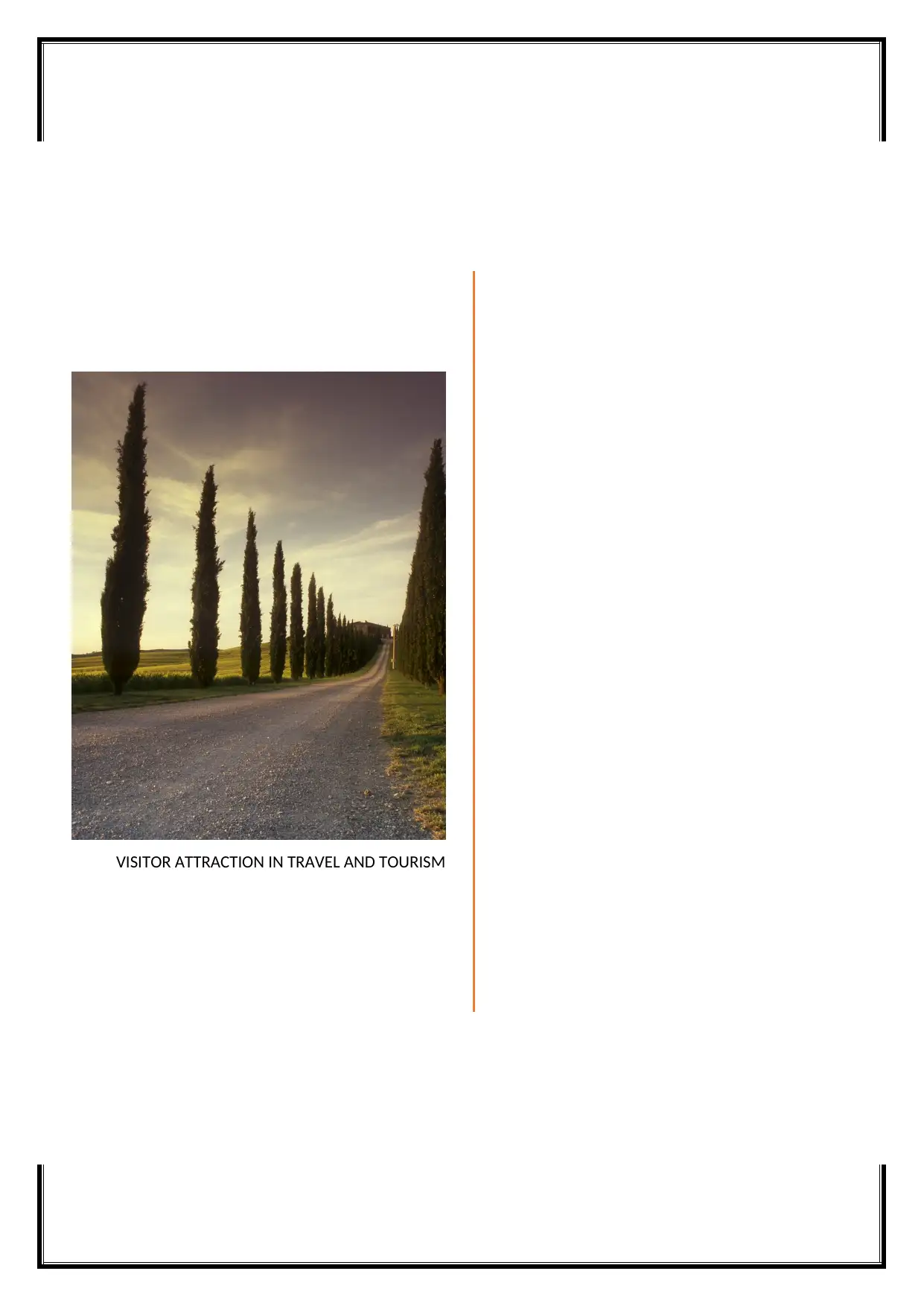
VISITOR ATTRACTION IN TRAVEL AND TOURISM
Secure Best Marks with AI Grader
Need help grading? Try our AI Grader for instant feedback on your assignments.
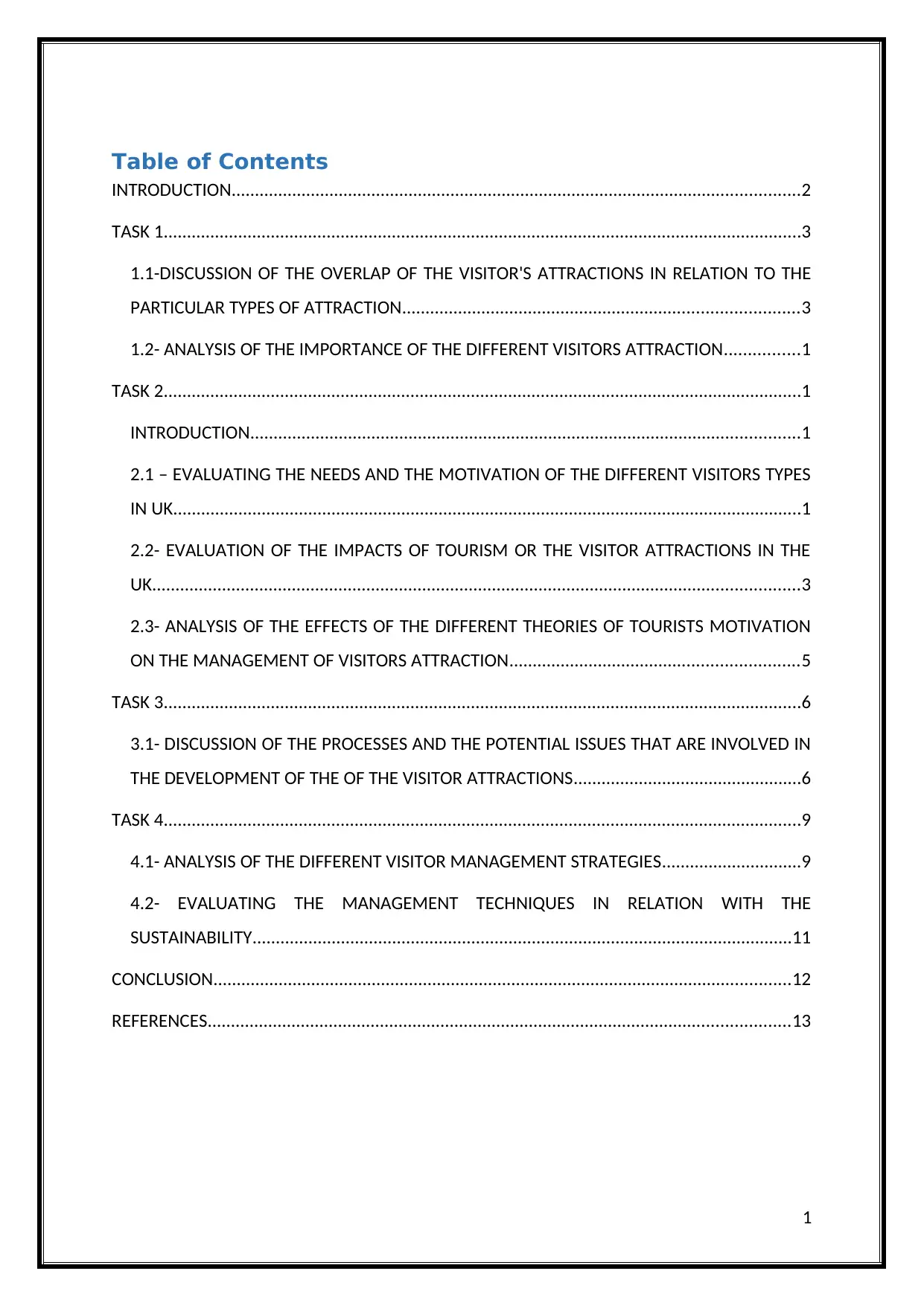
Table of Contents
INTRODUCTION..........................................................................................................................2
TASK 1.........................................................................................................................................3
1.1-DISCUSSION OF THE OVERLAP OF THE VISITOR'S ATTRACTIONS IN RELATION TO THE
PARTICULAR TYPES OF ATTRACTION.....................................................................................3
1.2- ANALYSIS OF THE IMPORTANCE OF THE DIFFERENT VISITORS ATTRACTION................1
TASK 2.........................................................................................................................................1
INTRODUCTION......................................................................................................................1
2.1 – EVALUATING THE NEEDS AND THE MOTIVATION OF THE DIFFERENT VISITORS TYPES
IN UK.......................................................................................................................................1
2.2- EVALUATION OF THE IMPACTS OF TOURISM OR THE VISITOR ATTRACTIONS IN THE
UK...........................................................................................................................................3
2.3- ANALYSIS OF THE EFFECTS OF THE DIFFERENT THEORIES OF TOURISTS MOTIVATION
ON THE MANAGEMENT OF VISITORS ATTRACTION..............................................................5
TASK 3.........................................................................................................................................6
3.1- DISCUSSION OF THE PROCESSES AND THE POTENTIAL ISSUES THAT ARE INVOLVED IN
THE DEVELOPMENT OF THE OF THE VISITOR ATTRACTIONS.................................................6
TASK 4.........................................................................................................................................9
4.1- ANALYSIS OF THE DIFFERENT VISITOR MANAGEMENT STRATEGIES..............................9
4.2- EVALUATING THE MANAGEMENT TECHNIQUES IN RELATION WITH THE
SUSTAINABILITY....................................................................................................................11
CONCLUSION............................................................................................................................12
REFERENCES.............................................................................................................................13
1
INTRODUCTION..........................................................................................................................2
TASK 1.........................................................................................................................................3
1.1-DISCUSSION OF THE OVERLAP OF THE VISITOR'S ATTRACTIONS IN RELATION TO THE
PARTICULAR TYPES OF ATTRACTION.....................................................................................3
1.2- ANALYSIS OF THE IMPORTANCE OF THE DIFFERENT VISITORS ATTRACTION................1
TASK 2.........................................................................................................................................1
INTRODUCTION......................................................................................................................1
2.1 – EVALUATING THE NEEDS AND THE MOTIVATION OF THE DIFFERENT VISITORS TYPES
IN UK.......................................................................................................................................1
2.2- EVALUATION OF THE IMPACTS OF TOURISM OR THE VISITOR ATTRACTIONS IN THE
UK...........................................................................................................................................3
2.3- ANALYSIS OF THE EFFECTS OF THE DIFFERENT THEORIES OF TOURISTS MOTIVATION
ON THE MANAGEMENT OF VISITORS ATTRACTION..............................................................5
TASK 3.........................................................................................................................................6
3.1- DISCUSSION OF THE PROCESSES AND THE POTENTIAL ISSUES THAT ARE INVOLVED IN
THE DEVELOPMENT OF THE OF THE VISITOR ATTRACTIONS.................................................6
TASK 4.........................................................................................................................................9
4.1- ANALYSIS OF THE DIFFERENT VISITOR MANAGEMENT STRATEGIES..............................9
4.2- EVALUATING THE MANAGEMENT TECHNIQUES IN RELATION WITH THE
SUSTAINABILITY....................................................................................................................11
CONCLUSION............................................................................................................................12
REFERENCES.............................................................................................................................13
1
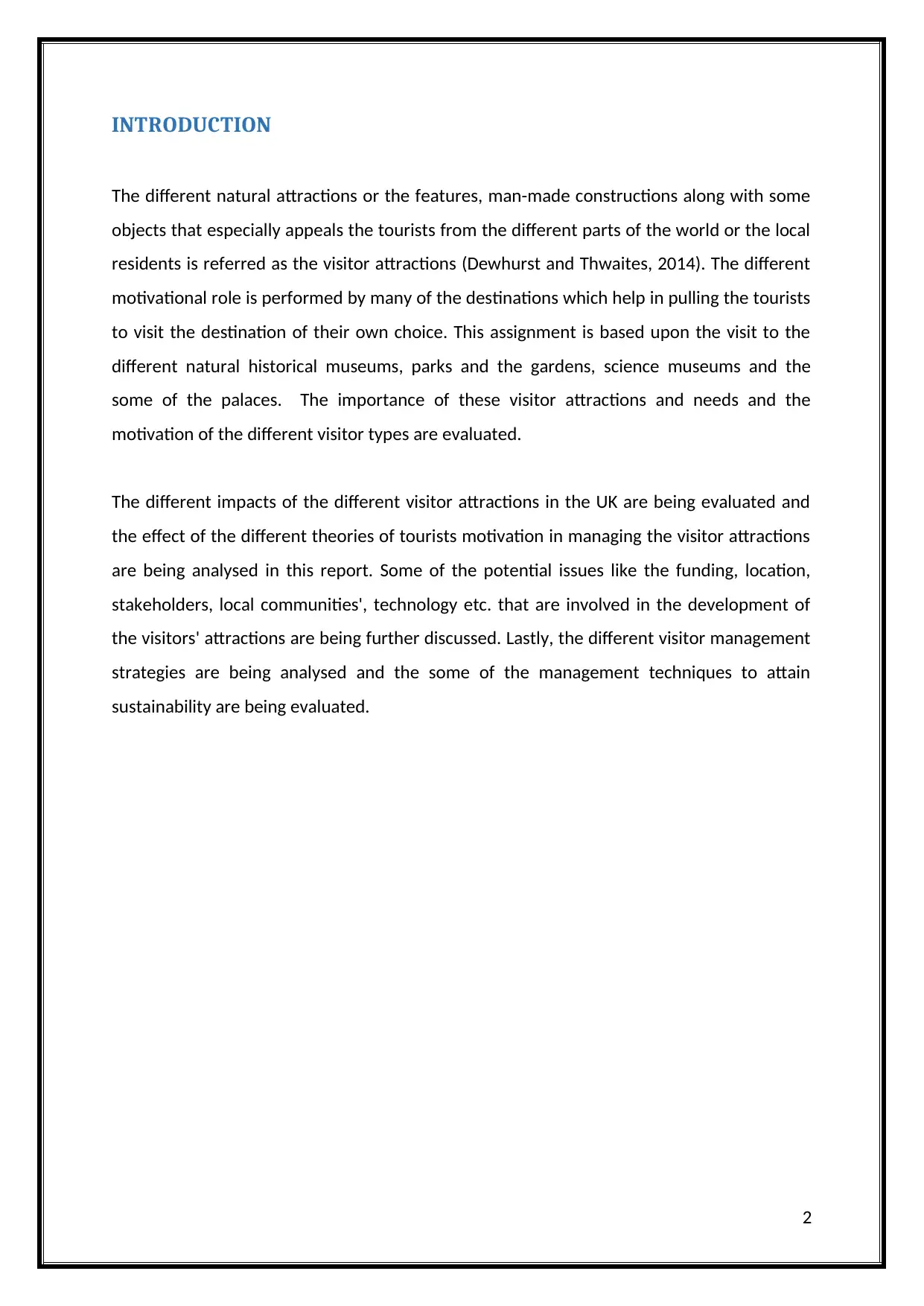
INTRODUCTION
The different natural attractions or the features, man-made constructions along with some
objects that especially appeals the tourists from the different parts of the world or the local
residents is referred as the visitor attractions (Dewhurst and Thwaites, 2014). The different
motivational role is performed by many of the destinations which help in pulling the tourists
to visit the destination of their own choice. This assignment is based upon the visit to the
different natural historical museums, parks and the gardens, science museums and the
some of the palaces. The importance of these visitor attractions and needs and the
motivation of the different visitor types are evaluated.
The different impacts of the different visitor attractions in the UK are being evaluated and
the effect of the different theories of tourists motivation in managing the visitor attractions
are being analysed in this report. Some of the potential issues like the funding, location,
stakeholders, local communities', technology etc. that are involved in the development of
the visitors' attractions are being further discussed. Lastly, the different visitor management
strategies are being analysed and the some of the management techniques to attain
sustainability are being evaluated.
2
The different natural attractions or the features, man-made constructions along with some
objects that especially appeals the tourists from the different parts of the world or the local
residents is referred as the visitor attractions (Dewhurst and Thwaites, 2014). The different
motivational role is performed by many of the destinations which help in pulling the tourists
to visit the destination of their own choice. This assignment is based upon the visit to the
different natural historical museums, parks and the gardens, science museums and the
some of the palaces. The importance of these visitor attractions and needs and the
motivation of the different visitor types are evaluated.
The different impacts of the different visitor attractions in the UK are being evaluated and
the effect of the different theories of tourists motivation in managing the visitor attractions
are being analysed in this report. Some of the potential issues like the funding, location,
stakeholders, local communities', technology etc. that are involved in the development of
the visitors' attractions are being further discussed. Lastly, the different visitor management
strategies are being analysed and the some of the management techniques to attain
sustainability are being evaluated.
2
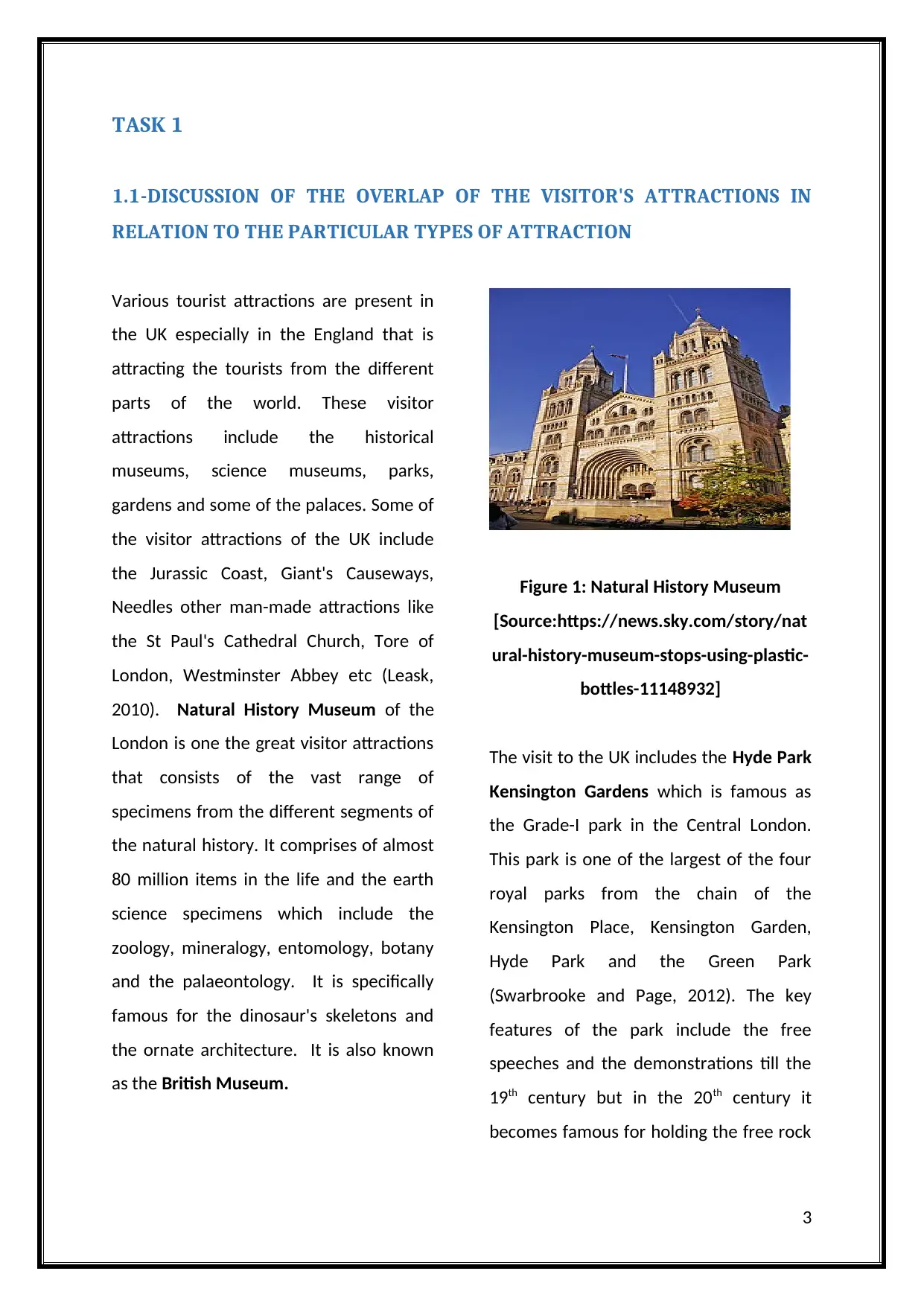
TASK 1
1.1-DISCUSSION OF THE OVERLAP OF THE VISITOR'S ATTRACTIONS IN
RELATION TO THE PARTICULAR TYPES OF ATTRACTION
Various tourist attractions are present in
the UK especially in the England that is
attracting the tourists from the different
parts of the world. These visitor
attractions include the historical
museums, science museums, parks,
gardens and some of the palaces. Some of
the visitor attractions of the UK include
the Jurassic Coast, Giant's Causeways,
Needles other man-made attractions like
the St Paul's Cathedral Church, Tore of
London, Westminster Abbey etc (Leask,
2010). Natural History Museum of the
London is one the great visitor attractions
that consists of the vast range of
specimens from the different segments of
the natural history. It comprises of almost
80 million items in the life and the earth
science specimens which include the
zoology, mineralogy, entomology, botany
and the palaeontology. It is specifically
famous for the dinosaur's skeletons and
the ornate architecture. It is also known
as the British Museum.
Figure 1: Natural History Museum
[Source:https://news.sky.com/story/nat
ural-history-museum-stops-using-plastic-
bottles-11148932]
The visit to the UK includes the Hyde Park
Kensington Gardens which is famous as
the Grade-I park in the Central London.
This park is one of the largest of the four
royal parks from the chain of the
Kensington Place, Kensington Garden,
Hyde Park and the Green Park
(Swarbrooke and Page, 2012). The key
features of the park include the free
speeches and the demonstrations till the
19th century but in the 20th century it
becomes famous for holding the free rock
3
1.1-DISCUSSION OF THE OVERLAP OF THE VISITOR'S ATTRACTIONS IN
RELATION TO THE PARTICULAR TYPES OF ATTRACTION
Various tourist attractions are present in
the UK especially in the England that is
attracting the tourists from the different
parts of the world. These visitor
attractions include the historical
museums, science museums, parks,
gardens and some of the palaces. Some of
the visitor attractions of the UK include
the Jurassic Coast, Giant's Causeways,
Needles other man-made attractions like
the St Paul's Cathedral Church, Tore of
London, Westminster Abbey etc (Leask,
2010). Natural History Museum of the
London is one the great visitor attractions
that consists of the vast range of
specimens from the different segments of
the natural history. It comprises of almost
80 million items in the life and the earth
science specimens which include the
zoology, mineralogy, entomology, botany
and the palaeontology. It is specifically
famous for the dinosaur's skeletons and
the ornate architecture. It is also known
as the British Museum.
Figure 1: Natural History Museum
[Source:https://news.sky.com/story/nat
ural-history-museum-stops-using-plastic-
bottles-11148932]
The visit to the UK includes the Hyde Park
Kensington Gardens which is famous as
the Grade-I park in the Central London.
This park is one of the largest of the four
royal parks from the chain of the
Kensington Place, Kensington Garden,
Hyde Park and the Green Park
(Swarbrooke and Page, 2012). The key
features of the park include the free
speeches and the demonstrations till the
19th century but in the 20th century it
becomes famous for holding the free rock
3
Secure Best Marks with AI Grader
Need help grading? Try our AI Grader for instant feedback on your assignments.
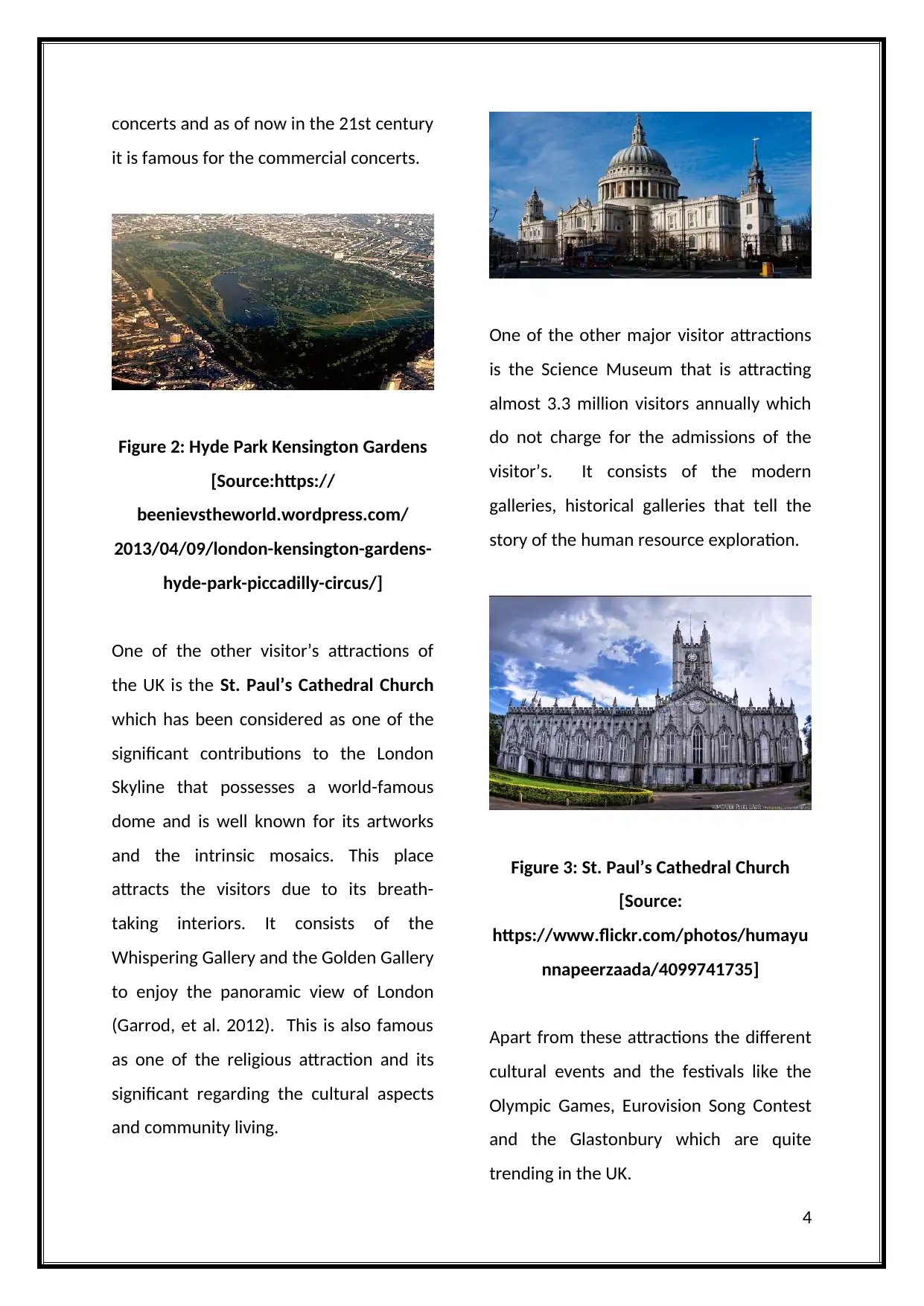
concerts and as of now in the 21st century
it is famous for the commercial concerts.
Figure 2: Hyde Park Kensington Gardens
[Source:https://
beenievstheworld.wordpress.com/
2013/04/09/london-kensington-gardens-
hyde-park-piccadilly-circus/]
One of the other visitor’s attractions of
the UK is the St. Paul’s Cathedral Church
which has been considered as one of the
significant contributions to the London
Skyline that possesses a world-famous
dome and is well known for its artworks
and the intrinsic mosaics. This place
attracts the visitors due to its breath-
taking interiors. It consists of the
Whispering Gallery and the Golden Gallery
to enjoy the panoramic view of London
(Garrod, et al. 2012). This is also famous
as one of the religious attraction and its
significant regarding the cultural aspects
and community living.
One of the other major visitor attractions
is the Science Museum that is attracting
almost 3.3 million visitors annually which
do not charge for the admissions of the
visitor’s. It consists of the modern
galleries, historical galleries that tell the
story of the human resource exploration.
Figure 3: St. Paul’s Cathedral Church
[Source:
https://www.flickr.com/photos/humayu
nnapeerzaada/4099741735]
Apart from these attractions the different
cultural events and the festivals like the
Olympic Games, Eurovision Song Contest
and the Glastonbury which are quite
trending in the UK.
4
it is famous for the commercial concerts.
Figure 2: Hyde Park Kensington Gardens
[Source:https://
beenievstheworld.wordpress.com/
2013/04/09/london-kensington-gardens-
hyde-park-piccadilly-circus/]
One of the other visitor’s attractions of
the UK is the St. Paul’s Cathedral Church
which has been considered as one of the
significant contributions to the London
Skyline that possesses a world-famous
dome and is well known for its artworks
and the intrinsic mosaics. This place
attracts the visitors due to its breath-
taking interiors. It consists of the
Whispering Gallery and the Golden Gallery
to enjoy the panoramic view of London
(Garrod, et al. 2012). This is also famous
as one of the religious attraction and its
significant regarding the cultural aspects
and community living.
One of the other major visitor attractions
is the Science Museum that is attracting
almost 3.3 million visitors annually which
do not charge for the admissions of the
visitor’s. It consists of the modern
galleries, historical galleries that tell the
story of the human resource exploration.
Figure 3: St. Paul’s Cathedral Church
[Source:
https://www.flickr.com/photos/humayu
nnapeerzaada/4099741735]
Apart from these attractions the different
cultural events and the festivals like the
Olympic Games, Eurovision Song Contest
and the Glastonbury which are quite
trending in the UK.
4
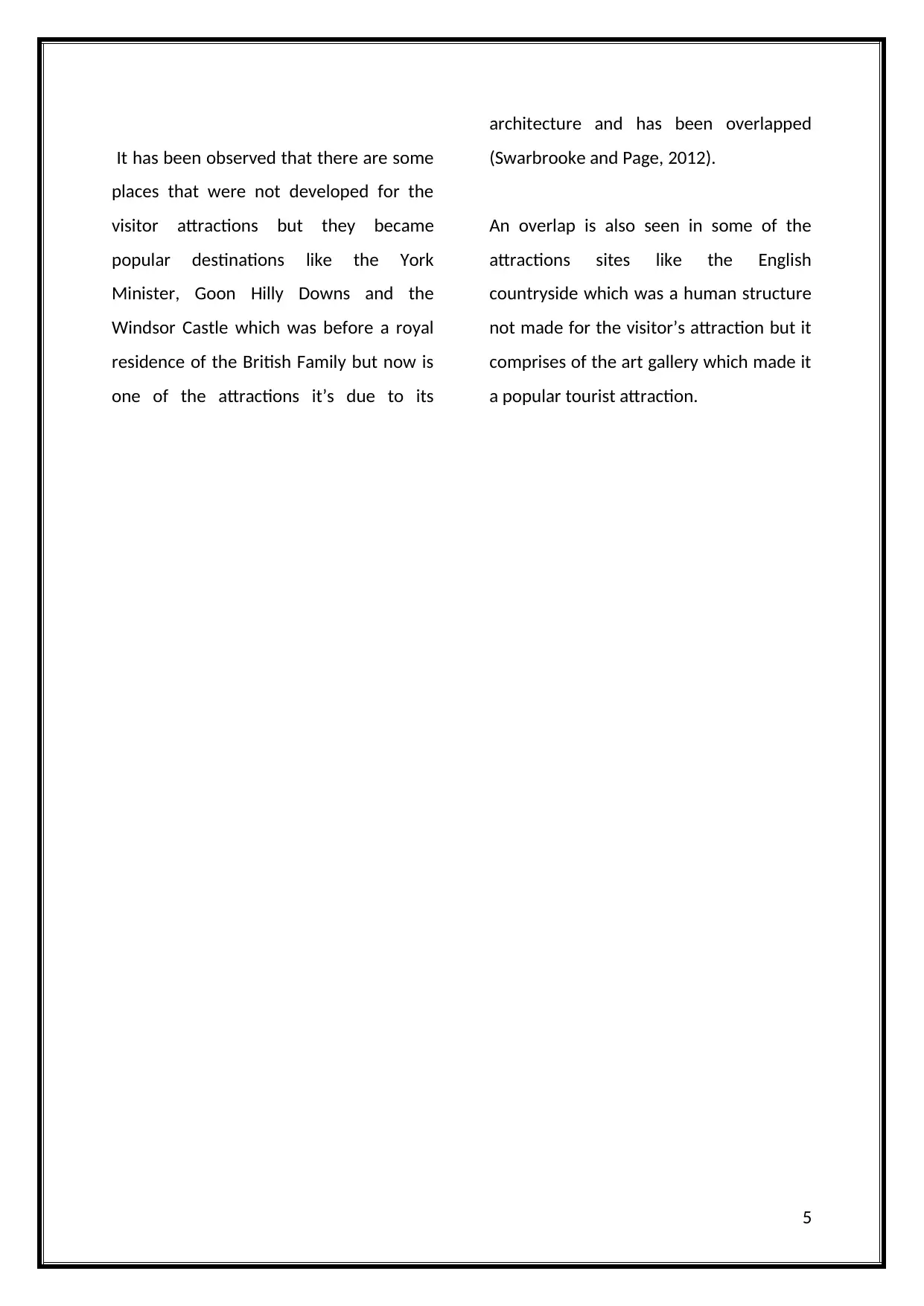
It has been observed that there are some
places that were not developed for the
visitor attractions but they became
popular destinations like the York
Minister, Goon Hilly Downs and the
Windsor Castle which was before a royal
residence of the British Family but now is
one of the attractions it’s due to its
architecture and has been overlapped
(Swarbrooke and Page, 2012).
An overlap is also seen in some of the
attractions sites like the English
countryside which was a human structure
not made for the visitor’s attraction but it
comprises of the art gallery which made it
a popular tourist attraction.
5
places that were not developed for the
visitor attractions but they became
popular destinations like the York
Minister, Goon Hilly Downs and the
Windsor Castle which was before a royal
residence of the British Family but now is
one of the attractions it’s due to its
architecture and has been overlapped
(Swarbrooke and Page, 2012).
An overlap is also seen in some of the
attractions sites like the English
countryside which was a human structure
not made for the visitor’s attraction but it
comprises of the art gallery which made it
a popular tourist attraction.
5
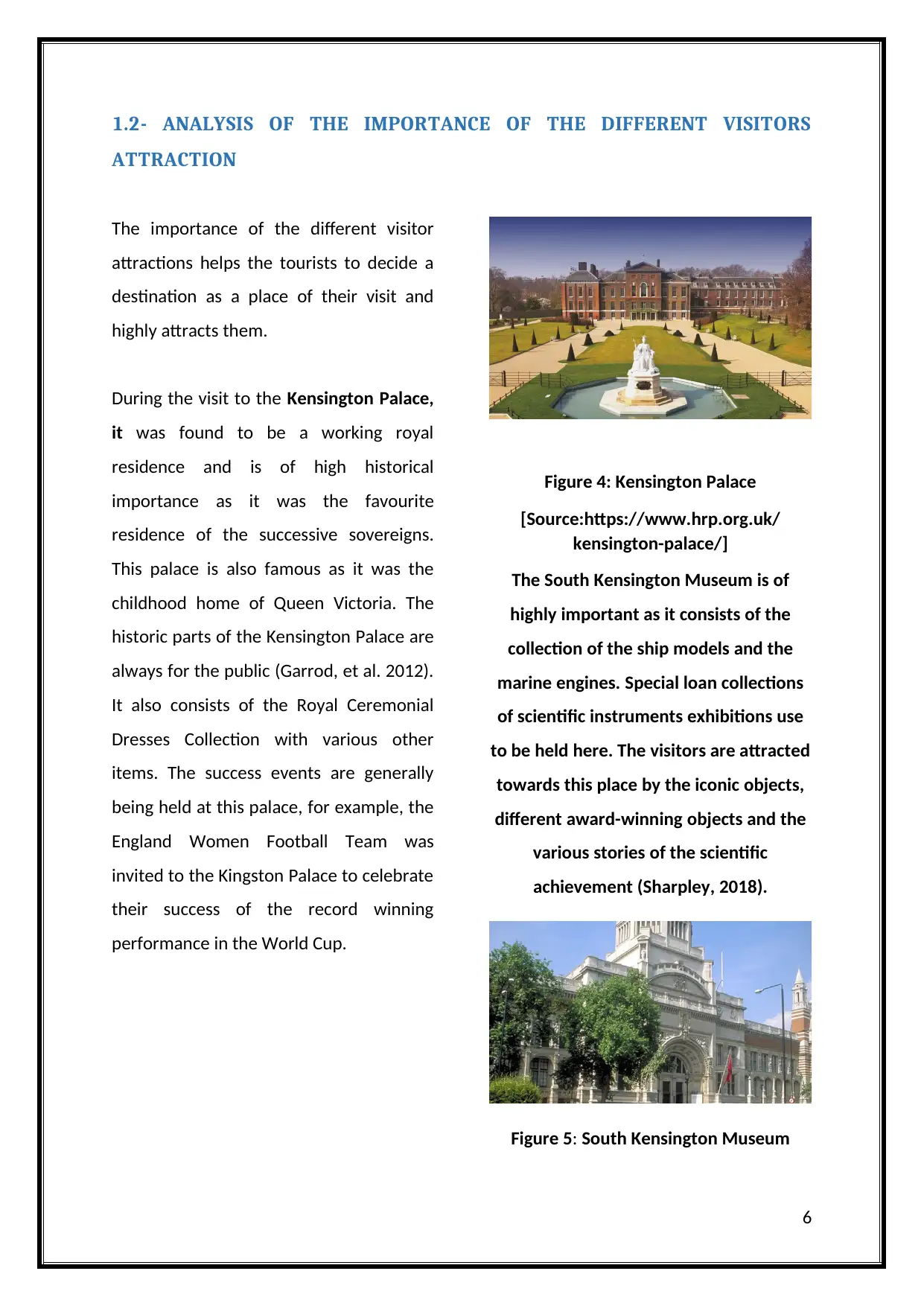
1.2- ANALYSIS OF THE IMPORTANCE OF THE DIFFERENT VISITORS
ATTRACTION
The importance of the different visitor
attractions helps the tourists to decide a
destination as a place of their visit and
highly attracts them.
During the visit to the Kensington Palace,
it was found to be a working royal
residence and is of high historical
importance as it was the favourite
residence of the successive sovereigns.
This palace is also famous as it was the
childhood home of Queen Victoria. The
historic parts of the Kensington Palace are
always for the public (Garrod, et al. 2012).
It also consists of the Royal Ceremonial
Dresses Collection with various other
items. The success events are generally
being held at this palace, for example, the
England Women Football Team was
invited to the Kingston Palace to celebrate
their success of the record winning
performance in the World Cup.
Figure 4: Kensington Palace
[Source:https://www.hrp.org.uk/
kensington-palace/]
The South Kensington Museum is of
highly important as it consists of the
collection of the ship models and the
marine engines. Special loan collections
of scientific instruments exhibitions use
to be held here. The visitors are attracted
towards this place by the iconic objects,
different award-winning objects and the
various stories of the scientific
achievement (Sharpley, 2018).
Figure 5: South Kensington Museum
6
ATTRACTION
The importance of the different visitor
attractions helps the tourists to decide a
destination as a place of their visit and
highly attracts them.
During the visit to the Kensington Palace,
it was found to be a working royal
residence and is of high historical
importance as it was the favourite
residence of the successive sovereigns.
This palace is also famous as it was the
childhood home of Queen Victoria. The
historic parts of the Kensington Palace are
always for the public (Garrod, et al. 2012).
It also consists of the Royal Ceremonial
Dresses Collection with various other
items. The success events are generally
being held at this palace, for example, the
England Women Football Team was
invited to the Kingston Palace to celebrate
their success of the record winning
performance in the World Cup.
Figure 4: Kensington Palace
[Source:https://www.hrp.org.uk/
kensington-palace/]
The South Kensington Museum is of
highly important as it consists of the
collection of the ship models and the
marine engines. Special loan collections
of scientific instruments exhibitions use
to be held here. The visitors are attracted
towards this place by the iconic objects,
different award-winning objects and the
various stories of the scientific
achievement (Sharpley, 2018).
Figure 5: South Kensington Museum
6
Paraphrase This Document
Need a fresh take? Get an instant paraphrase of this document with our AI Paraphraser
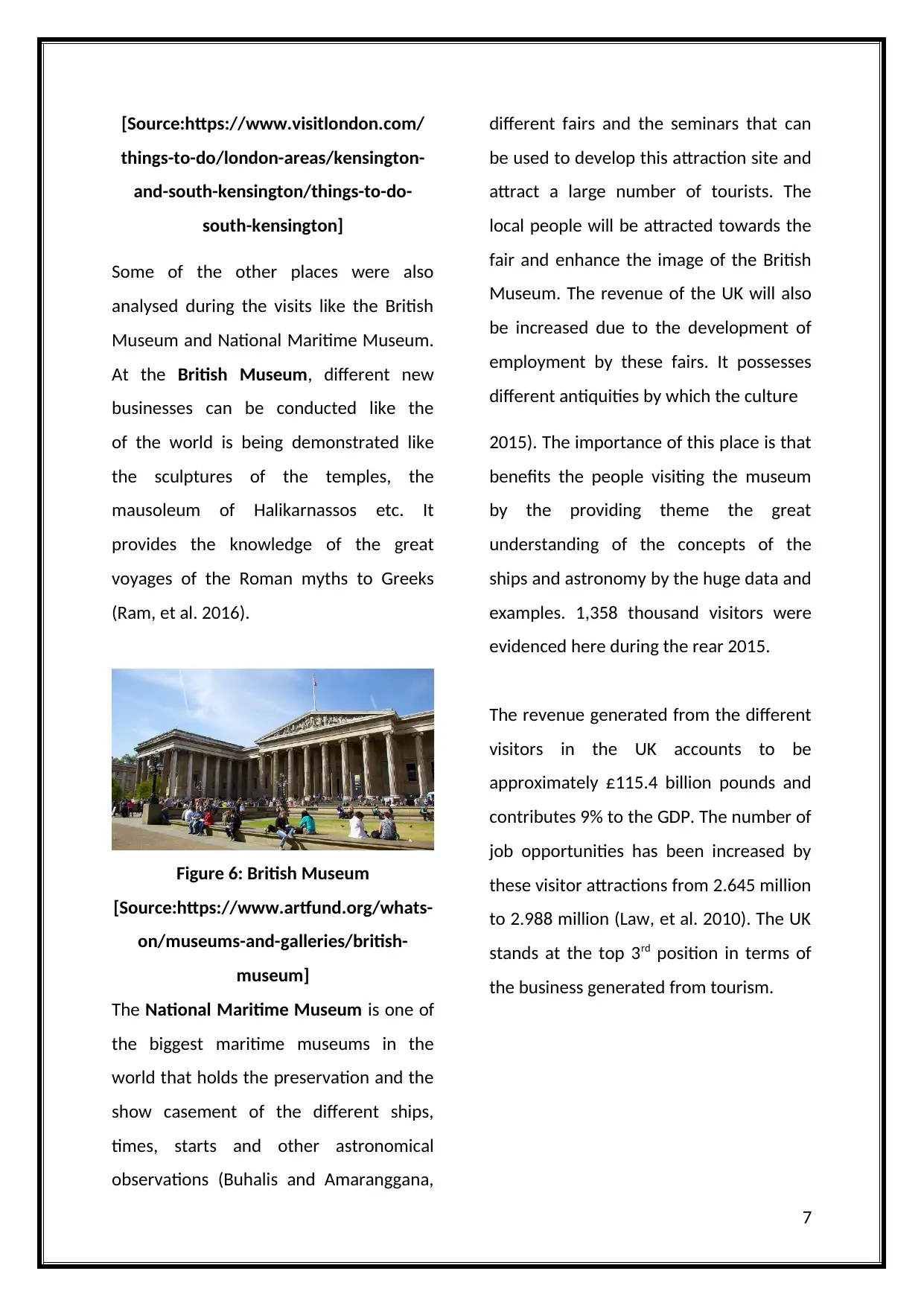
[Source:https://www.visitlondon.com/
things-to-do/london-areas/kensington-
and-south-kensington/things-to-do-
south-kensington]
Some of the other places were also
analysed during the visits like the British
Museum and National Maritime Museum.
At the British Museum, different new
businesses can be conducted like the
different fairs and the seminars that can
be used to develop this attraction site and
attract a large number of tourists. The
local people will be attracted towards the
fair and enhance the image of the British
Museum. The revenue of the UK will also
be increased due to the development of
employment by these fairs. It possesses
different antiquities by which the culture
of the world is being demonstrated like
the sculptures of the temples, the
mausoleum of Halikarnassos etc. It
provides the knowledge of the great
voyages of the Roman myths to Greeks
(Ram, et al. 2016).
Figure 6: British Museum
[Source:https://www.artfund.org/whats-
on/museums-and-galleries/british-
museum]
The National Maritime Museum is one of
the biggest maritime museums in the
world that holds the preservation and the
show casement of the different ships,
times, starts and other astronomical
observations (Buhalis and Amaranggana,
2015). The importance of this place is that
benefits the people visiting the museum
by the providing theme the great
understanding of the concepts of the
ships and astronomy by the huge data and
examples. 1,358 thousand visitors were
evidenced here during the rear 2015.
The revenue generated from the different
visitors in the UK accounts to be
approximately £115.4 billion pounds and
contributes 9% to the GDP. The number of
job opportunities has been increased by
these visitor attractions from 2.645 million
to 2.988 million (Law, et al. 2010). The UK
stands at the top 3rd position in terms of
the business generated from tourism.
7
things-to-do/london-areas/kensington-
and-south-kensington/things-to-do-
south-kensington]
Some of the other places were also
analysed during the visits like the British
Museum and National Maritime Museum.
At the British Museum, different new
businesses can be conducted like the
different fairs and the seminars that can
be used to develop this attraction site and
attract a large number of tourists. The
local people will be attracted towards the
fair and enhance the image of the British
Museum. The revenue of the UK will also
be increased due to the development of
employment by these fairs. It possesses
different antiquities by which the culture
of the world is being demonstrated like
the sculptures of the temples, the
mausoleum of Halikarnassos etc. It
provides the knowledge of the great
voyages of the Roman myths to Greeks
(Ram, et al. 2016).
Figure 6: British Museum
[Source:https://www.artfund.org/whats-
on/museums-and-galleries/british-
museum]
The National Maritime Museum is one of
the biggest maritime museums in the
world that holds the preservation and the
show casement of the different ships,
times, starts and other astronomical
observations (Buhalis and Amaranggana,
2015). The importance of this place is that
benefits the people visiting the museum
by the providing theme the great
understanding of the concepts of the
ships and astronomy by the huge data and
examples. 1,358 thousand visitors were
evidenced here during the rear 2015.
The revenue generated from the different
visitors in the UK accounts to be
approximately £115.4 billion pounds and
contributes 9% to the GDP. The number of
job opportunities has been increased by
these visitor attractions from 2.645 million
to 2.988 million (Law, et al. 2010). The UK
stands at the top 3rd position in terms of
the business generated from tourism.
7
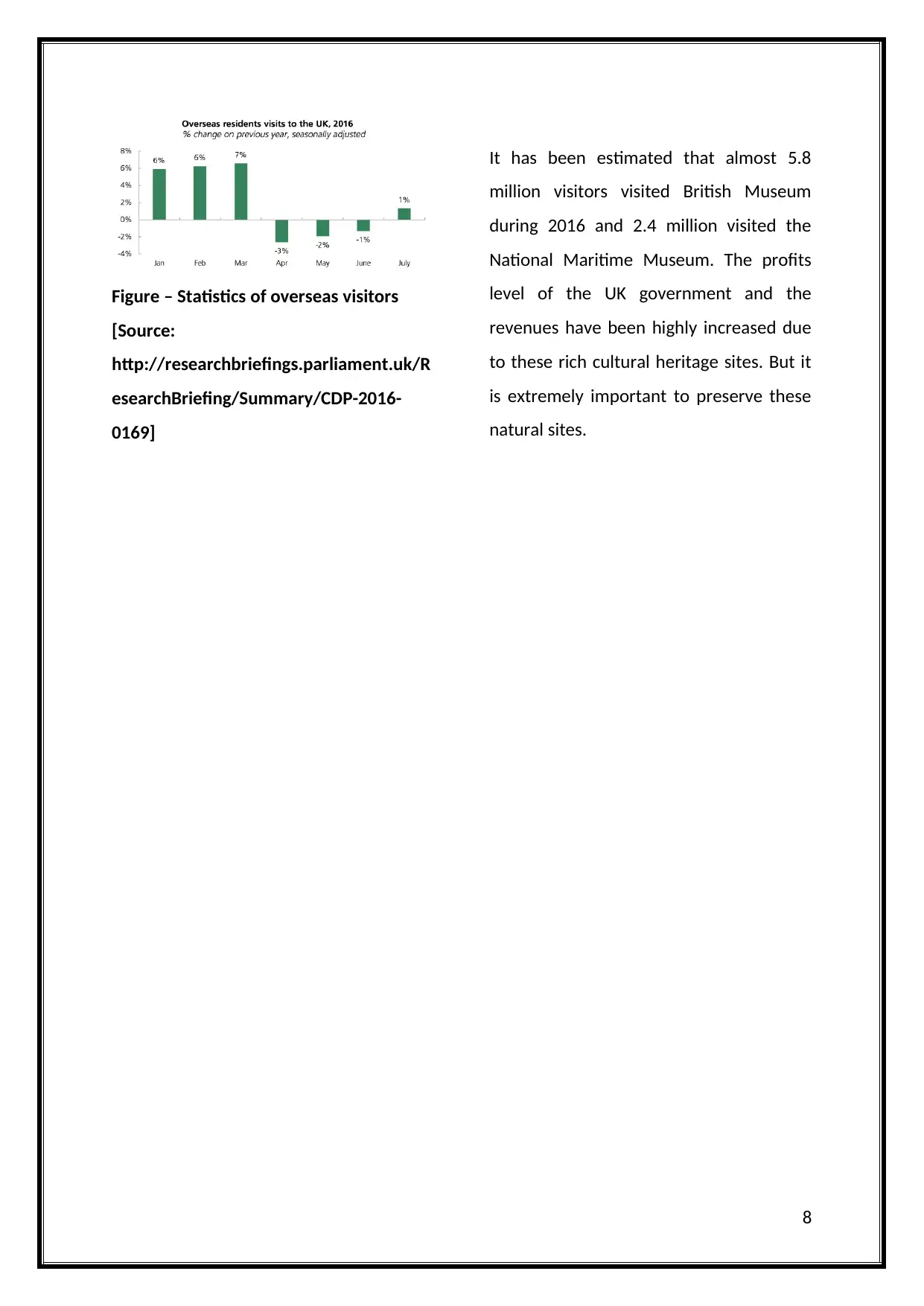
Figure – Statistics of overseas visitors
[Source:
http://researchbriefings.parliament.uk/R
esearchBriefing/Summary/CDP-2016-
0169]
It has been estimated that almost 5.8
million visitors visited British Museum
during 2016 and 2.4 million visited the
National Maritime Museum. The profits
level of the UK government and the
revenues have been highly increased due
to these rich cultural heritage sites. But it
is extremely important to preserve these
natural sites.
8
[Source:
http://researchbriefings.parliament.uk/R
esearchBriefing/Summary/CDP-2016-
0169]
It has been estimated that almost 5.8
million visitors visited British Museum
during 2016 and 2.4 million visited the
National Maritime Museum. The profits
level of the UK government and the
revenues have been highly increased due
to these rich cultural heritage sites. But it
is extremely important to preserve these
natural sites.
8
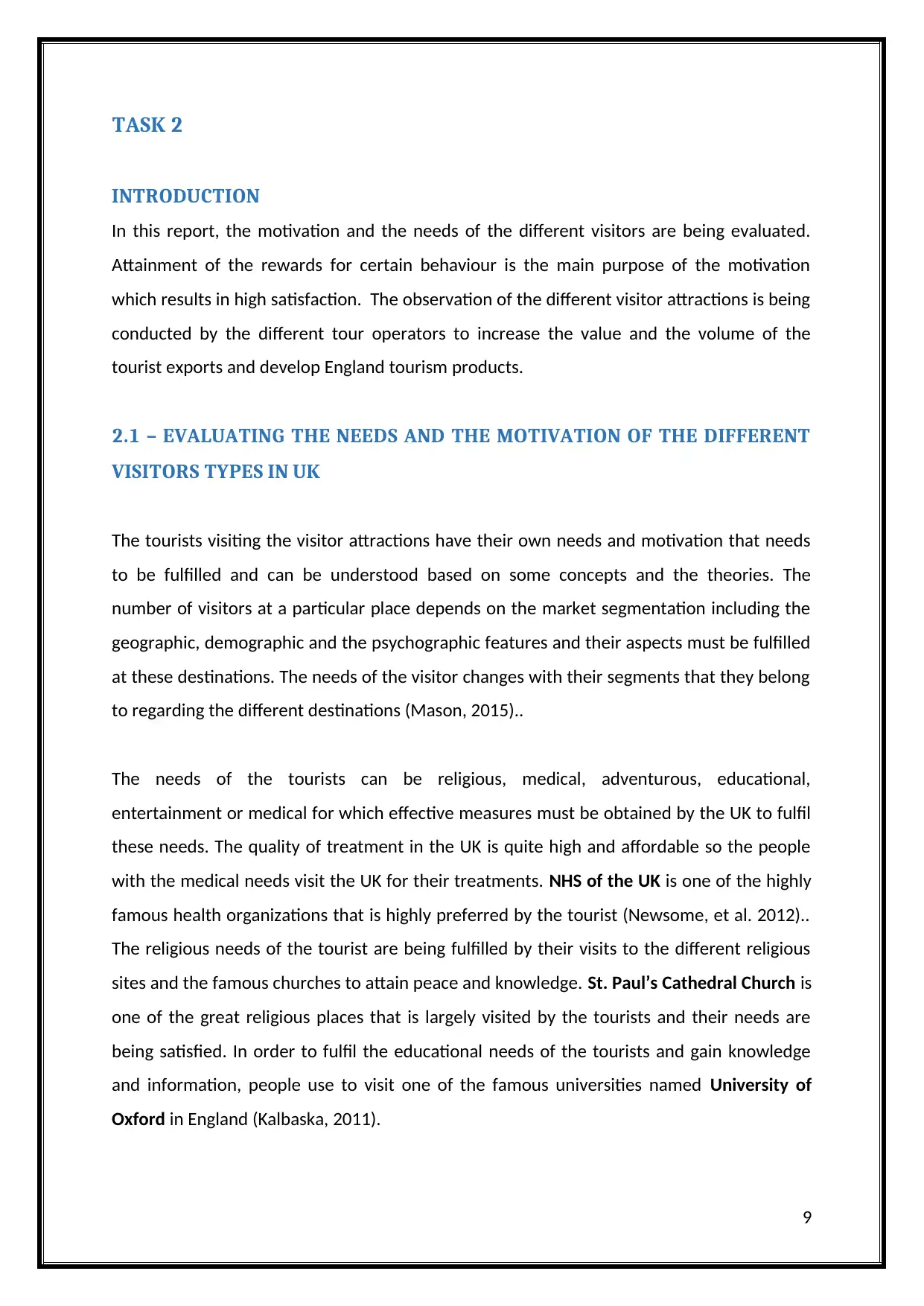
TASK 2
INTRODUCTION
In this report, the motivation and the needs of the different visitors are being evaluated.
Attainment of the rewards for certain behaviour is the main purpose of the motivation
which results in high satisfaction. The observation of the different visitor attractions is being
conducted by the different tour operators to increase the value and the volume of the
tourist exports and develop England tourism products.
2.1 – EVALUATING THE NEEDS AND THE MOTIVATION OF THE DIFFERENT
VISITORS TYPES IN UK
The tourists visiting the visitor attractions have their own needs and motivation that needs
to be fulfilled and can be understood based on some concepts and the theories. The
number of visitors at a particular place depends on the market segmentation including the
geographic, demographic and the psychographic features and their aspects must be fulfilled
at these destinations. The needs of the visitor changes with their segments that they belong
to regarding the different destinations (Mason, 2015)..
The needs of the tourists can be religious, medical, adventurous, educational,
entertainment or medical for which effective measures must be obtained by the UK to fulfil
these needs. The quality of treatment in the UK is quite high and affordable so the people
with the medical needs visit the UK for their treatments. NHS of the UK is one of the highly
famous health organizations that is highly preferred by the tourist (Newsome, et al. 2012)..
The religious needs of the tourist are being fulfilled by their visits to the different religious
sites and the famous churches to attain peace and knowledge. St. Paul’s Cathedral Church is
one of the great religious places that is largely visited by the tourists and their needs are
being satisfied. In order to fulfil the educational needs of the tourists and gain knowledge
and information, people use to visit one of the famous universities named University of
Oxford in England (Kalbaska, 2011).
9
INTRODUCTION
In this report, the motivation and the needs of the different visitors are being evaluated.
Attainment of the rewards for certain behaviour is the main purpose of the motivation
which results in high satisfaction. The observation of the different visitor attractions is being
conducted by the different tour operators to increase the value and the volume of the
tourist exports and develop England tourism products.
2.1 – EVALUATING THE NEEDS AND THE MOTIVATION OF THE DIFFERENT
VISITORS TYPES IN UK
The tourists visiting the visitor attractions have their own needs and motivation that needs
to be fulfilled and can be understood based on some concepts and the theories. The
number of visitors at a particular place depends on the market segmentation including the
geographic, demographic and the psychographic features and their aspects must be fulfilled
at these destinations. The needs of the visitor changes with their segments that they belong
to regarding the different destinations (Mason, 2015)..
The needs of the tourists can be religious, medical, adventurous, educational,
entertainment or medical for which effective measures must be obtained by the UK to fulfil
these needs. The quality of treatment in the UK is quite high and affordable so the people
with the medical needs visit the UK for their treatments. NHS of the UK is one of the highly
famous health organizations that is highly preferred by the tourist (Newsome, et al. 2012)..
The religious needs of the tourist are being fulfilled by their visits to the different religious
sites and the famous churches to attain peace and knowledge. St. Paul’s Cathedral Church is
one of the great religious places that is largely visited by the tourists and their needs are
being satisfied. In order to fulfil the educational needs of the tourists and gain knowledge
and information, people use to visit one of the famous universities named University of
Oxford in England (Kalbaska, 2011).
9
Secure Best Marks with AI Grader
Need help grading? Try our AI Grader for instant feedback on your assignments.
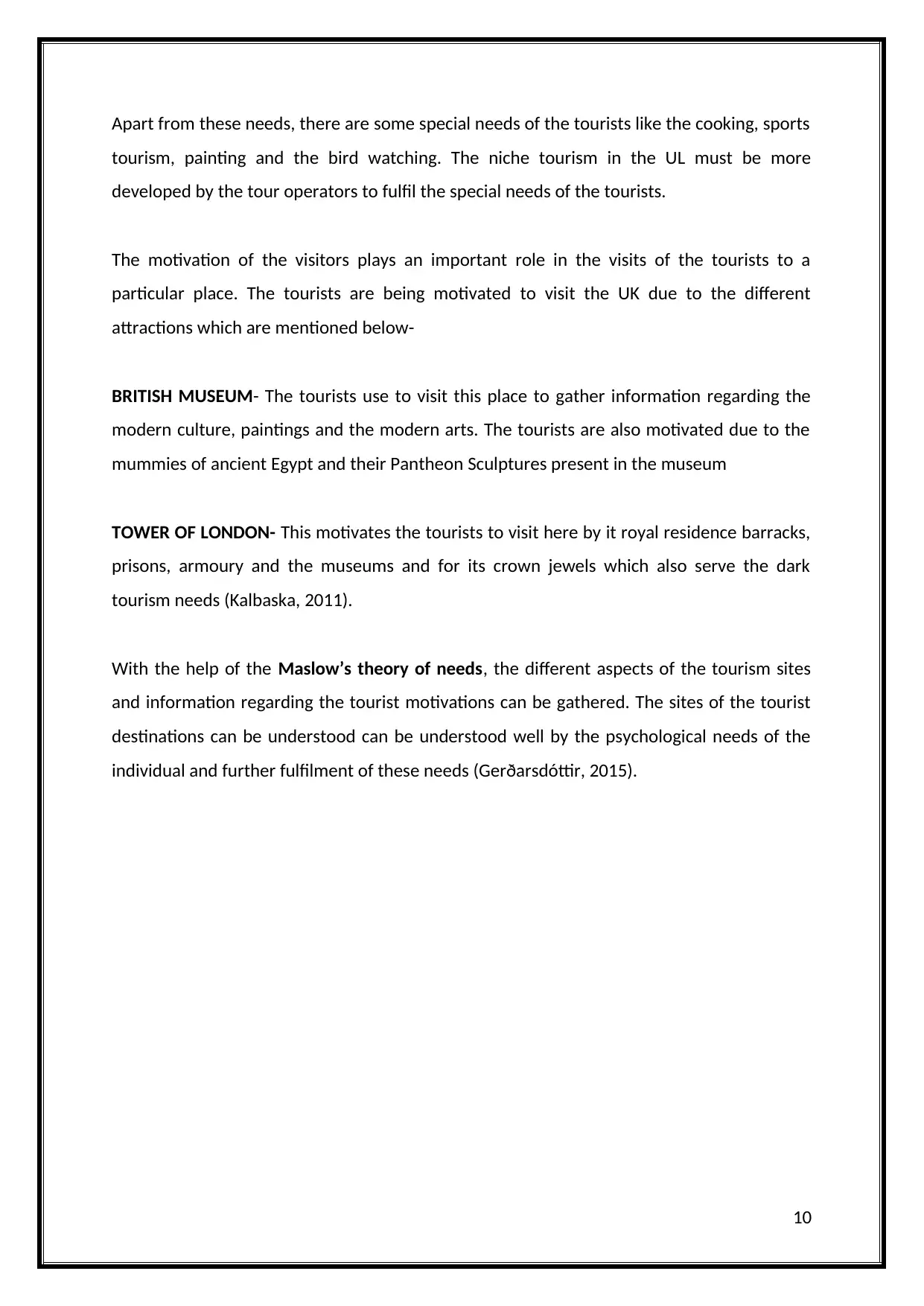
Apart from these needs, there are some special needs of the tourists like the cooking, sports
tourism, painting and the bird watching. The niche tourism in the UL must be more
developed by the tour operators to fulfil the special needs of the tourists.
The motivation of the visitors plays an important role in the visits of the tourists to a
particular place. The tourists are being motivated to visit the UK due to the different
attractions which are mentioned below-
BRITISH MUSEUM- The tourists use to visit this place to gather information regarding the
modern culture, paintings and the modern arts. The tourists are also motivated due to the
mummies of ancient Egypt and their Pantheon Sculptures present in the museum
TOWER OF LONDON- This motivates the tourists to visit here by it royal residence barracks,
prisons, armoury and the museums and for its crown jewels which also serve the dark
tourism needs (Kalbaska, 2011).
With the help of the Maslow’s theory of needs, the different aspects of the tourism sites
and information regarding the tourist motivations can be gathered. The sites of the tourist
destinations can be understood can be understood well by the psychological needs of the
individual and further fulfilment of these needs (Gerðarsdóttir, 2015).
10
tourism, painting and the bird watching. The niche tourism in the UL must be more
developed by the tour operators to fulfil the special needs of the tourists.
The motivation of the visitors plays an important role in the visits of the tourists to a
particular place. The tourists are being motivated to visit the UK due to the different
attractions which are mentioned below-
BRITISH MUSEUM- The tourists use to visit this place to gather information regarding the
modern culture, paintings and the modern arts. The tourists are also motivated due to the
mummies of ancient Egypt and their Pantheon Sculptures present in the museum
TOWER OF LONDON- This motivates the tourists to visit here by it royal residence barracks,
prisons, armoury and the museums and for its crown jewels which also serve the dark
tourism needs (Kalbaska, 2011).
With the help of the Maslow’s theory of needs, the different aspects of the tourism sites
and information regarding the tourist motivations can be gathered. The sites of the tourist
destinations can be understood can be understood well by the psychological needs of the
individual and further fulfilment of these needs (Gerðarsdóttir, 2015).
10
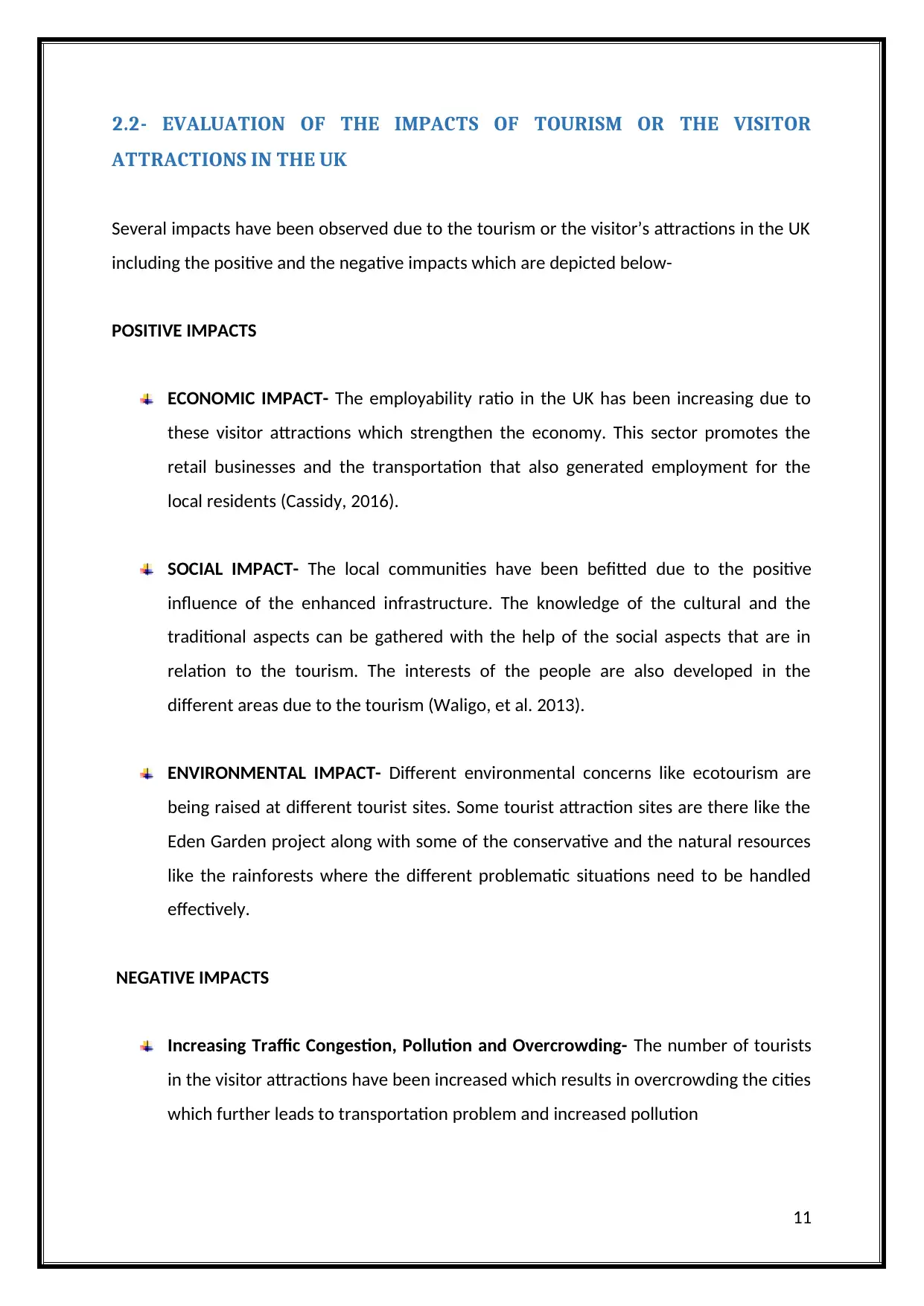
2.2- EVALUATION OF THE IMPACTS OF TOURISM OR THE VISITOR
ATTRACTIONS IN THE UK
Several impacts have been observed due to the tourism or the visitor’s attractions in the UK
including the positive and the negative impacts which are depicted below-
POSITIVE IMPACTS
ECONOMIC IMPACT- The employability ratio in the UK has been increasing due to
these visitor attractions which strengthen the economy. This sector promotes the
retail businesses and the transportation that also generated employment for the
local residents (Cassidy, 2016).
SOCIAL IMPACT- The local communities have been befitted due to the positive
influence of the enhanced infrastructure. The knowledge of the cultural and the
traditional aspects can be gathered with the help of the social aspects that are in
relation to the tourism. The interests of the people are also developed in the
different areas due to the tourism (Waligo, et al. 2013).
ENVIRONMENTAL IMPACT- Different environmental concerns like ecotourism are
being raised at different tourist sites. Some tourist attraction sites are there like the
Eden Garden project along with some of the conservative and the natural resources
like the rainforests where the different problematic situations need to be handled
effectively.
NEGATIVE IMPACTS
Increasing Traffic Congestion, Pollution and Overcrowding- The number of tourists
in the visitor attractions have been increased which results in overcrowding the cities
which further leads to transportation problem and increased pollution
11
ATTRACTIONS IN THE UK
Several impacts have been observed due to the tourism or the visitor’s attractions in the UK
including the positive and the negative impacts which are depicted below-
POSITIVE IMPACTS
ECONOMIC IMPACT- The employability ratio in the UK has been increasing due to
these visitor attractions which strengthen the economy. This sector promotes the
retail businesses and the transportation that also generated employment for the
local residents (Cassidy, 2016).
SOCIAL IMPACT- The local communities have been befitted due to the positive
influence of the enhanced infrastructure. The knowledge of the cultural and the
traditional aspects can be gathered with the help of the social aspects that are in
relation to the tourism. The interests of the people are also developed in the
different areas due to the tourism (Waligo, et al. 2013).
ENVIRONMENTAL IMPACT- Different environmental concerns like ecotourism are
being raised at different tourist sites. Some tourist attraction sites are there like the
Eden Garden project along with some of the conservative and the natural resources
like the rainforests where the different problematic situations need to be handled
effectively.
NEGATIVE IMPACTS
Increasing Traffic Congestion, Pollution and Overcrowding- The number of tourists
in the visitor attractions have been increased which results in overcrowding the cities
which further leads to transportation problem and increased pollution
11
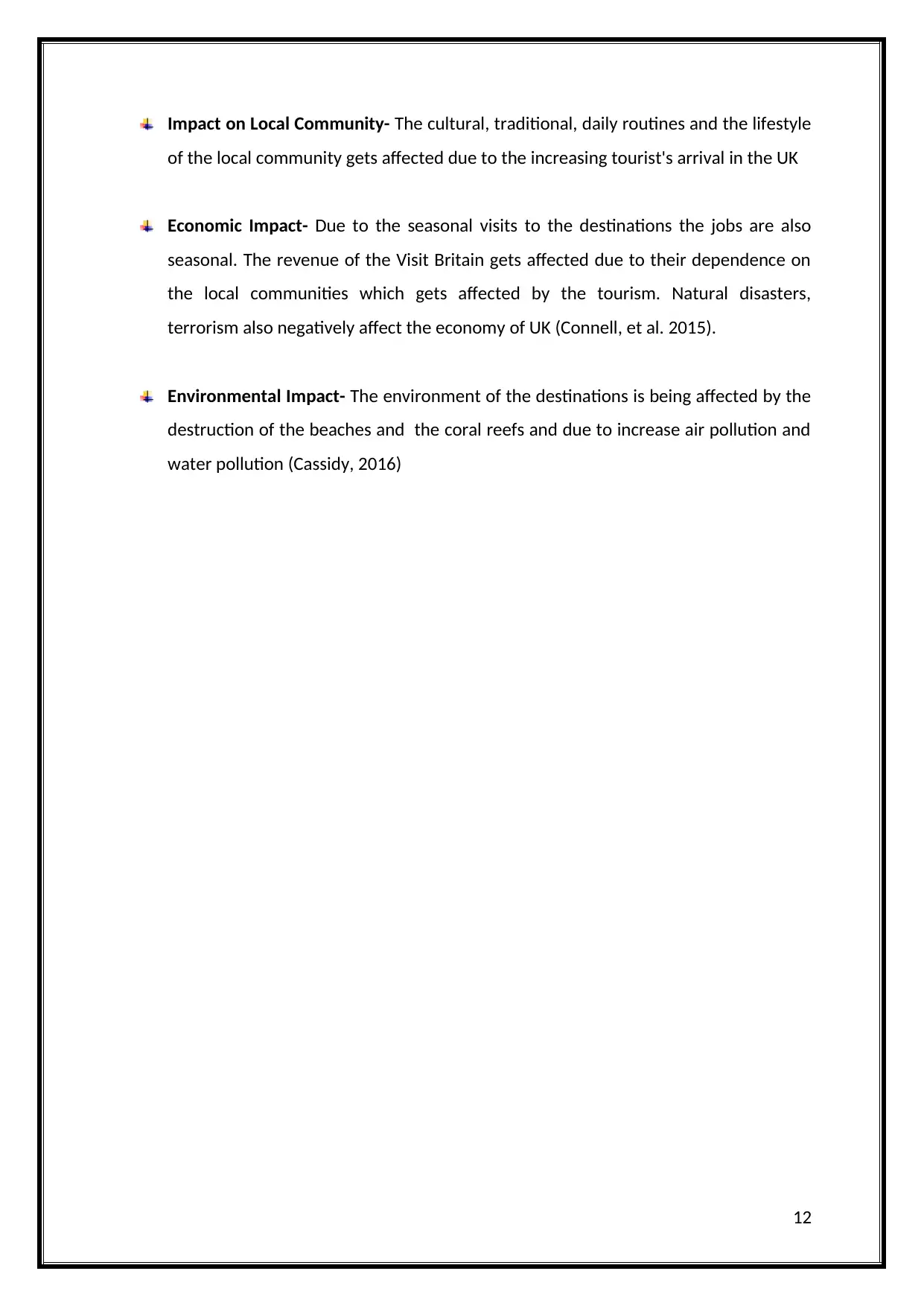
Impact on Local Community- The cultural, traditional, daily routines and the lifestyle
of the local community gets affected due to the increasing tourist's arrival in the UK
Economic Impact- Due to the seasonal visits to the destinations the jobs are also
seasonal. The revenue of the Visit Britain gets affected due to their dependence on
the local communities which gets affected by the tourism. Natural disasters,
terrorism also negatively affect the economy of UK (Connell, et al. 2015).
Environmental Impact- The environment of the destinations is being affected by the
destruction of the beaches and the coral reefs and due to increase air pollution and
water pollution (Cassidy, 2016)
12
of the local community gets affected due to the increasing tourist's arrival in the UK
Economic Impact- Due to the seasonal visits to the destinations the jobs are also
seasonal. The revenue of the Visit Britain gets affected due to their dependence on
the local communities which gets affected by the tourism. Natural disasters,
terrorism also negatively affect the economy of UK (Connell, et al. 2015).
Environmental Impact- The environment of the destinations is being affected by the
destruction of the beaches and the coral reefs and due to increase air pollution and
water pollution (Cassidy, 2016)
12
Paraphrase This Document
Need a fresh take? Get an instant paraphrase of this document with our AI Paraphraser
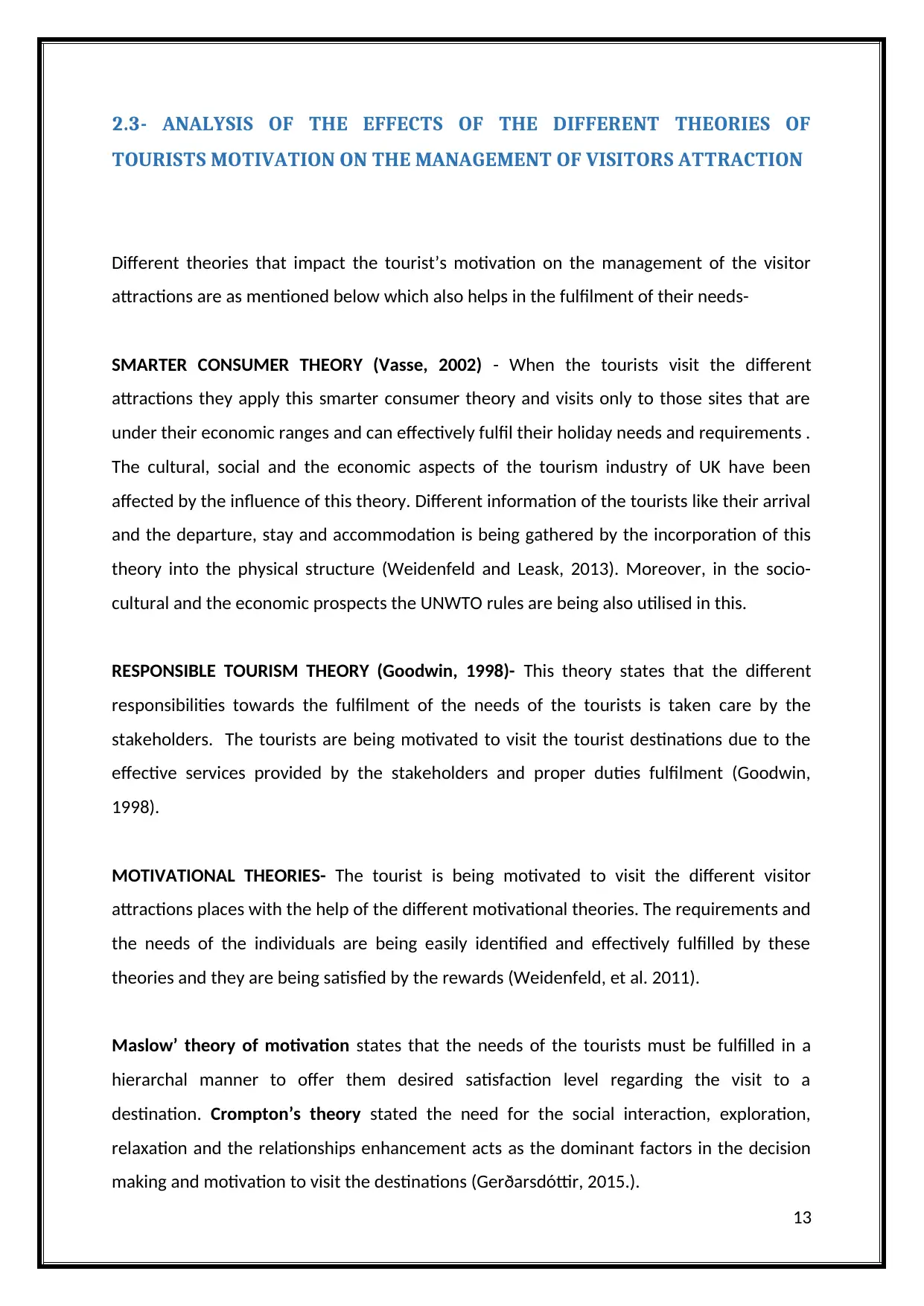
2.3- ANALYSIS OF THE EFFECTS OF THE DIFFERENT THEORIES OF
TOURISTS MOTIVATION ON THE MANAGEMENT OF VISITORS ATTRACTION
Different theories that impact the tourist’s motivation on the management of the visitor
attractions are as mentioned below which also helps in the fulfilment of their needs-
SMARTER CONSUMER THEORY (Vasse, 2002) - When the tourists visit the different
attractions they apply this smarter consumer theory and visits only to those sites that are
under their economic ranges and can effectively fulfil their holiday needs and requirements .
The cultural, social and the economic aspects of the tourism industry of UK have been
affected by the influence of this theory. Different information of the tourists like their arrival
and the departure, stay and accommodation is being gathered by the incorporation of this
theory into the physical structure (Weidenfeld and Leask, 2013). Moreover, in the socio-
cultural and the economic prospects the UNWTO rules are being also utilised in this.
RESPONSIBLE TOURISM THEORY (Goodwin, 1998)- This theory states that the different
responsibilities towards the fulfilment of the needs of the tourists is taken care by the
stakeholders. The tourists are being motivated to visit the tourist destinations due to the
effective services provided by the stakeholders and proper duties fulfilment (Goodwin,
1998).
MOTIVATIONAL THEORIES- The tourist is being motivated to visit the different visitor
attractions places with the help of the different motivational theories. The requirements and
the needs of the individuals are being easily identified and effectively fulfilled by these
theories and they are being satisfied by the rewards (Weidenfeld, et al. 2011).
Maslow’ theory of motivation states that the needs of the tourists must be fulfilled in a
hierarchal manner to offer them desired satisfaction level regarding the visit to a
destination. Crompton’s theory stated the need for the social interaction, exploration,
relaxation and the relationships enhancement acts as the dominant factors in the decision
making and motivation to visit the destinations (Gerðarsdóttir, 2015.).
13
TOURISTS MOTIVATION ON THE MANAGEMENT OF VISITORS ATTRACTION
Different theories that impact the tourist’s motivation on the management of the visitor
attractions are as mentioned below which also helps in the fulfilment of their needs-
SMARTER CONSUMER THEORY (Vasse, 2002) - When the tourists visit the different
attractions they apply this smarter consumer theory and visits only to those sites that are
under their economic ranges and can effectively fulfil their holiday needs and requirements .
The cultural, social and the economic aspects of the tourism industry of UK have been
affected by the influence of this theory. Different information of the tourists like their arrival
and the departure, stay and accommodation is being gathered by the incorporation of this
theory into the physical structure (Weidenfeld and Leask, 2013). Moreover, in the socio-
cultural and the economic prospects the UNWTO rules are being also utilised in this.
RESPONSIBLE TOURISM THEORY (Goodwin, 1998)- This theory states that the different
responsibilities towards the fulfilment of the needs of the tourists is taken care by the
stakeholders. The tourists are being motivated to visit the tourist destinations due to the
effective services provided by the stakeholders and proper duties fulfilment (Goodwin,
1998).
MOTIVATIONAL THEORIES- The tourist is being motivated to visit the different visitor
attractions places with the help of the different motivational theories. The requirements and
the needs of the individuals are being easily identified and effectively fulfilled by these
theories and they are being satisfied by the rewards (Weidenfeld, et al. 2011).
Maslow’ theory of motivation states that the needs of the tourists must be fulfilled in a
hierarchal manner to offer them desired satisfaction level regarding the visit to a
destination. Crompton’s theory stated the need for the social interaction, exploration,
relaxation and the relationships enhancement acts as the dominant factors in the decision
making and motivation to visit the destinations (Gerðarsdóttir, 2015.).
13
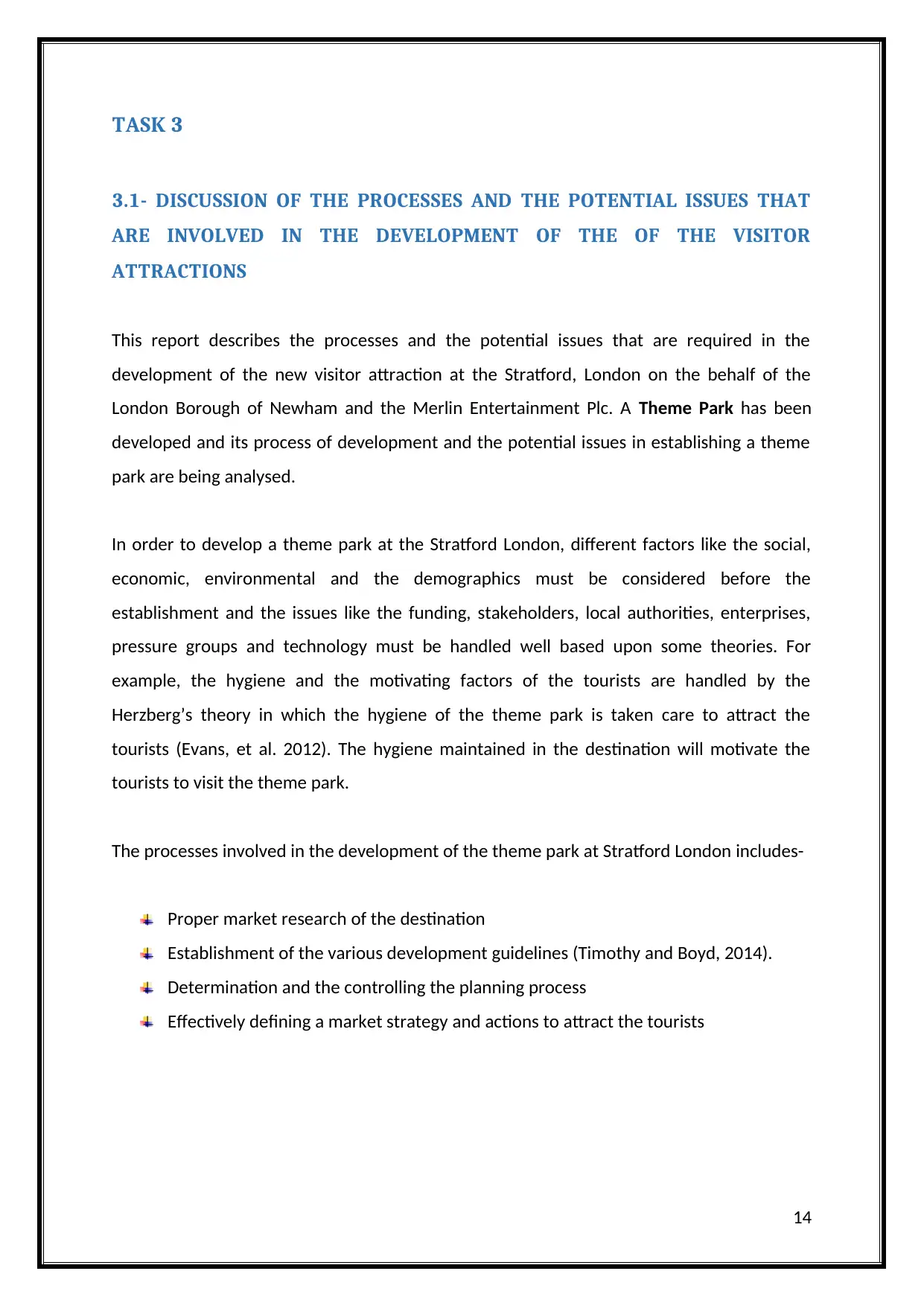
TASK 3
3.1- DISCUSSION OF THE PROCESSES AND THE POTENTIAL ISSUES THAT
ARE INVOLVED IN THE DEVELOPMENT OF THE OF THE VISITOR
ATTRACTIONS
This report describes the processes and the potential issues that are required in the
development of the new visitor attraction at the Stratford, London on the behalf of the
London Borough of Newham and the Merlin Entertainment Plc. A Theme Park has been
developed and its process of development and the potential issues in establishing a theme
park are being analysed.
In order to develop a theme park at the Stratford London, different factors like the social,
economic, environmental and the demographics must be considered before the
establishment and the issues like the funding, stakeholders, local authorities, enterprises,
pressure groups and technology must be handled well based upon some theories. For
example, the hygiene and the motivating factors of the tourists are handled by the
Herzberg’s theory in which the hygiene of the theme park is taken care to attract the
tourists (Evans, et al. 2012). The hygiene maintained in the destination will motivate the
tourists to visit the theme park.
The processes involved in the development of the theme park at Stratford London includes-
Proper market research of the destination
Establishment of the various development guidelines (Timothy and Boyd, 2014).
Determination and the controlling the planning process
Effectively defining a market strategy and actions to attract the tourists
14
3.1- DISCUSSION OF THE PROCESSES AND THE POTENTIAL ISSUES THAT
ARE INVOLVED IN THE DEVELOPMENT OF THE OF THE VISITOR
ATTRACTIONS
This report describes the processes and the potential issues that are required in the
development of the new visitor attraction at the Stratford, London on the behalf of the
London Borough of Newham and the Merlin Entertainment Plc. A Theme Park has been
developed and its process of development and the potential issues in establishing a theme
park are being analysed.
In order to develop a theme park at the Stratford London, different factors like the social,
economic, environmental and the demographics must be considered before the
establishment and the issues like the funding, stakeholders, local authorities, enterprises,
pressure groups and technology must be handled well based upon some theories. For
example, the hygiene and the motivating factors of the tourists are handled by the
Herzberg’s theory in which the hygiene of the theme park is taken care to attract the
tourists (Evans, et al. 2012). The hygiene maintained in the destination will motivate the
tourists to visit the theme park.
The processes involved in the development of the theme park at Stratford London includes-
Proper market research of the destination
Establishment of the various development guidelines (Timothy and Boyd, 2014).
Determination and the controlling the planning process
Effectively defining a market strategy and actions to attract the tourists
14
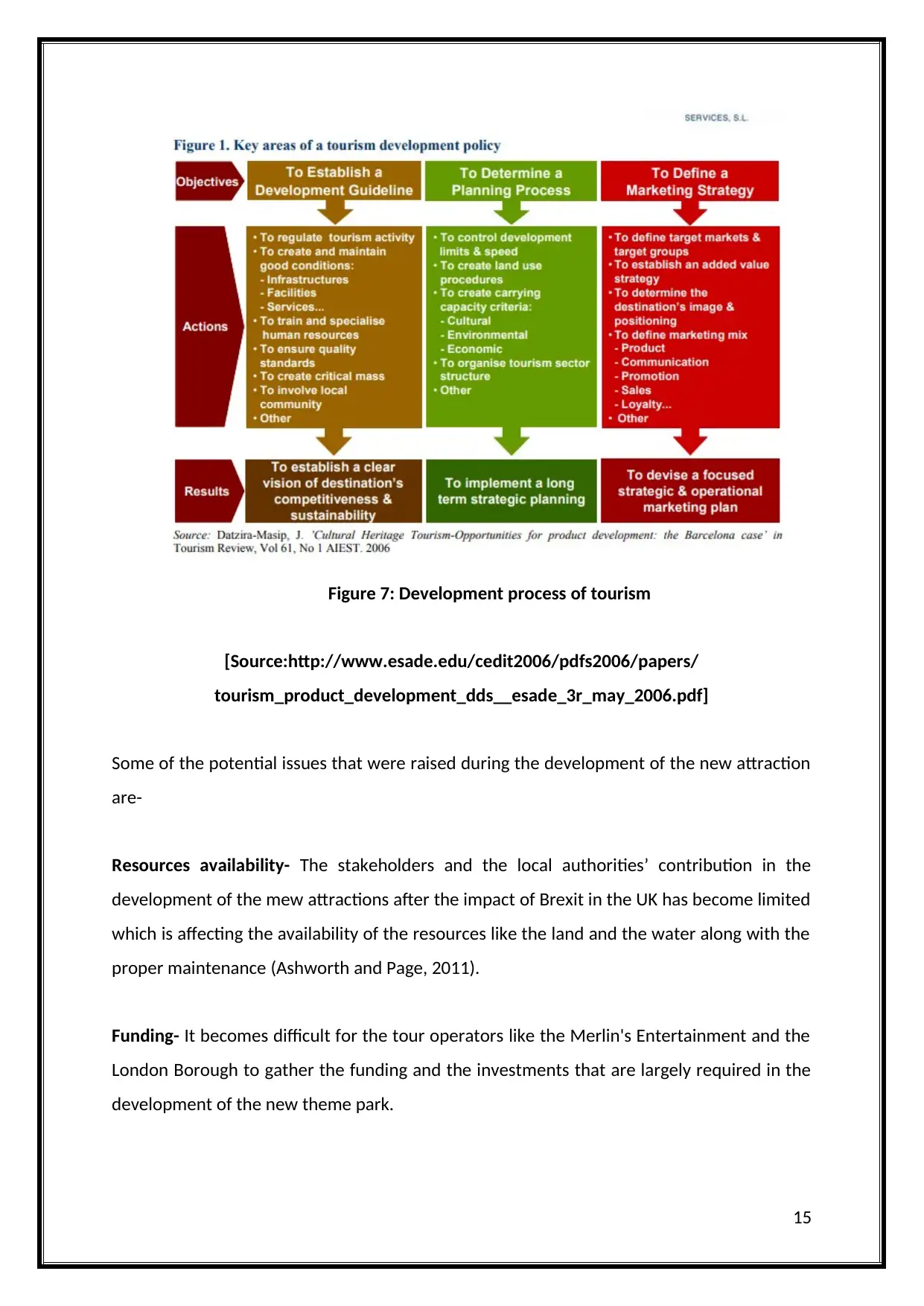
Figure 7: Development process of tourism
[Source:http://www.esade.edu/cedit2006/pdfs2006/papers/
tourism_product_development_dds__esade_3r_may_2006.pdf]
Some of the potential issues that were raised during the development of the new attraction
are-
Resources availability- The stakeholders and the local authorities’ contribution in the
development of the mew attractions after the impact of Brexit in the UK has become limited
which is affecting the availability of the resources like the land and the water along with the
proper maintenance (Ashworth and Page, 2011).
Funding- It becomes difficult for the tour operators like the Merlin's Entertainment and the
London Borough to gather the funding and the investments that are largely required in the
development of the new theme park.
15
[Source:http://www.esade.edu/cedit2006/pdfs2006/papers/
tourism_product_development_dds__esade_3r_may_2006.pdf]
Some of the potential issues that were raised during the development of the new attraction
are-
Resources availability- The stakeholders and the local authorities’ contribution in the
development of the mew attractions after the impact of Brexit in the UK has become limited
which is affecting the availability of the resources like the land and the water along with the
proper maintenance (Ashworth and Page, 2011).
Funding- It becomes difficult for the tour operators like the Merlin's Entertainment and the
London Borough to gather the funding and the investments that are largely required in the
development of the new theme park.
15
Secure Best Marks with AI Grader
Need help grading? Try our AI Grader for instant feedback on your assignments.
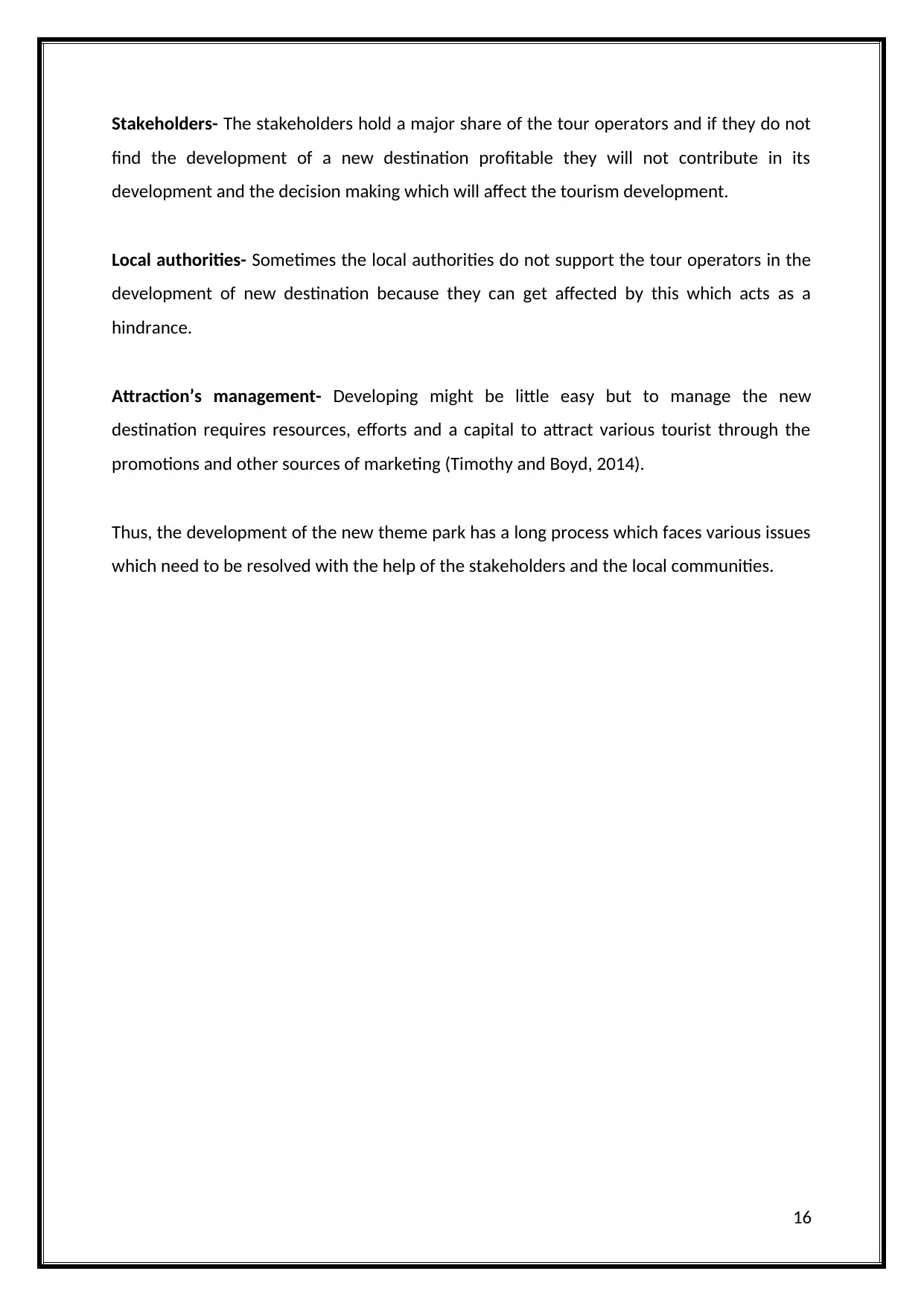
Stakeholders- The stakeholders hold a major share of the tour operators and if they do not
find the development of a new destination profitable they will not contribute in its
development and the decision making which will affect the tourism development.
Local authorities- Sometimes the local authorities do not support the tour operators in the
development of new destination because they can get affected by this which acts as a
hindrance.
Attraction’s management- Developing might be little easy but to manage the new
destination requires resources, efforts and a capital to attract various tourist through the
promotions and other sources of marketing (Timothy and Boyd, 2014).
Thus, the development of the new theme park has a long process which faces various issues
which need to be resolved with the help of the stakeholders and the local communities.
16
find the development of a new destination profitable they will not contribute in its
development and the decision making which will affect the tourism development.
Local authorities- Sometimes the local authorities do not support the tour operators in the
development of new destination because they can get affected by this which acts as a
hindrance.
Attraction’s management- Developing might be little easy but to manage the new
destination requires resources, efforts and a capital to attract various tourist through the
promotions and other sources of marketing (Timothy and Boyd, 2014).
Thus, the development of the new theme park has a long process which faces various issues
which need to be resolved with the help of the stakeholders and the local communities.
16
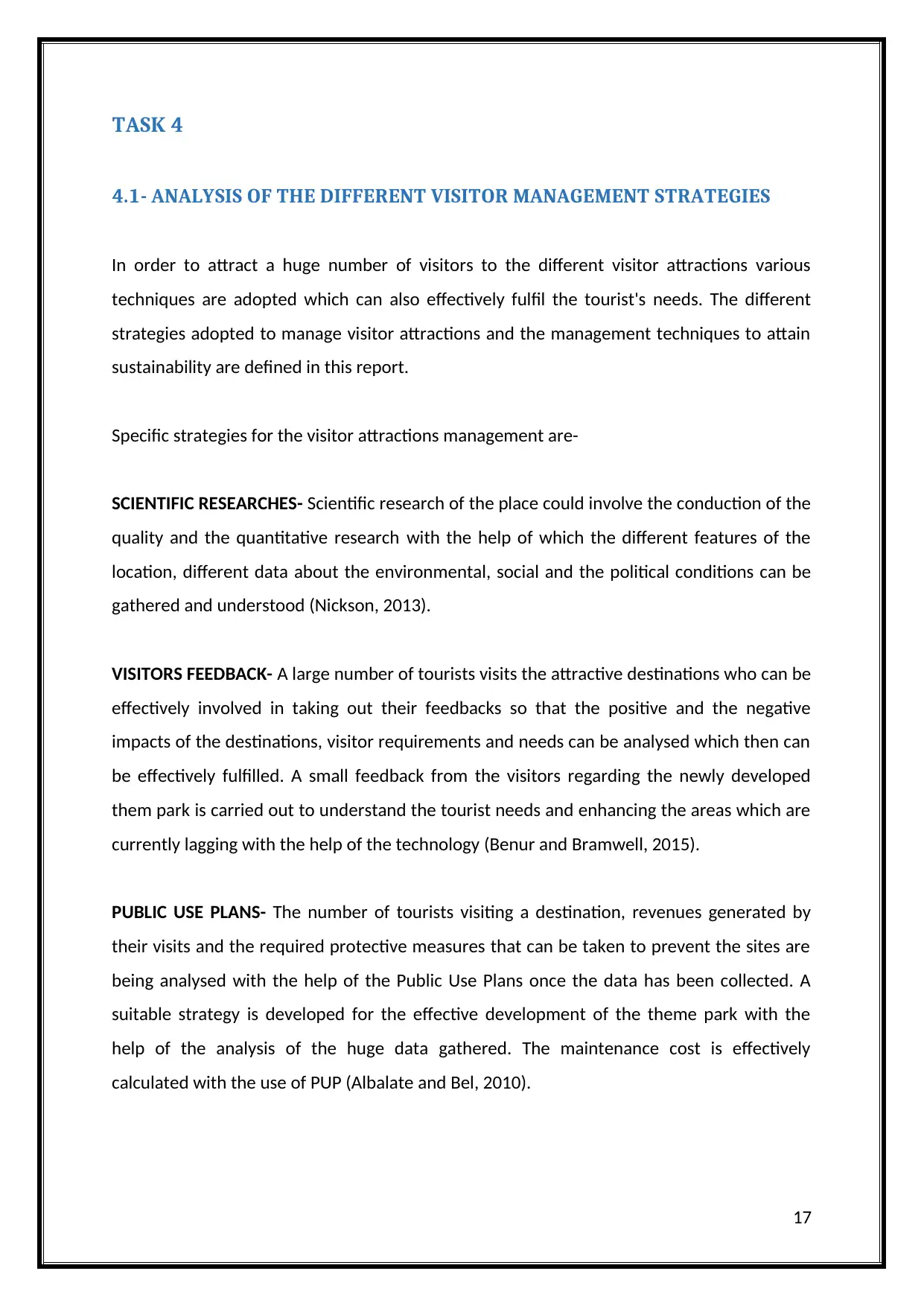
TASK 4
4.1- ANALYSIS OF THE DIFFERENT VISITOR MANAGEMENT STRATEGIES
In order to attract a huge number of visitors to the different visitor attractions various
techniques are adopted which can also effectively fulfil the tourist's needs. The different
strategies adopted to manage visitor attractions and the management techniques to attain
sustainability are defined in this report.
Specific strategies for the visitor attractions management are-
SCIENTIFIC RESEARCHES- Scientific research of the place could involve the conduction of the
quality and the quantitative research with the help of which the different features of the
location, different data about the environmental, social and the political conditions can be
gathered and understood (Nickson, 2013).
VISITORS FEEDBACK- A large number of tourists visits the attractive destinations who can be
effectively involved in taking out their feedbacks so that the positive and the negative
impacts of the destinations, visitor requirements and needs can be analysed which then can
be effectively fulfilled. A small feedback from the visitors regarding the newly developed
them park is carried out to understand the tourist needs and enhancing the areas which are
currently lagging with the help of the technology (Benur and Bramwell, 2015).
PUBLIC USE PLANS- The number of tourists visiting a destination, revenues generated by
their visits and the required protective measures that can be taken to prevent the sites are
being analysed with the help of the Public Use Plans once the data has been collected. A
suitable strategy is developed for the effective development of the theme park with the
help of the analysis of the huge data gathered. The maintenance cost is effectively
calculated with the use of PUP (Albalate and Bel, 2010).
17
4.1- ANALYSIS OF THE DIFFERENT VISITOR MANAGEMENT STRATEGIES
In order to attract a huge number of visitors to the different visitor attractions various
techniques are adopted which can also effectively fulfil the tourist's needs. The different
strategies adopted to manage visitor attractions and the management techniques to attain
sustainability are defined in this report.
Specific strategies for the visitor attractions management are-
SCIENTIFIC RESEARCHES- Scientific research of the place could involve the conduction of the
quality and the quantitative research with the help of which the different features of the
location, different data about the environmental, social and the political conditions can be
gathered and understood (Nickson, 2013).
VISITORS FEEDBACK- A large number of tourists visits the attractive destinations who can be
effectively involved in taking out their feedbacks so that the positive and the negative
impacts of the destinations, visitor requirements and needs can be analysed which then can
be effectively fulfilled. A small feedback from the visitors regarding the newly developed
them park is carried out to understand the tourist needs and enhancing the areas which are
currently lagging with the help of the technology (Benur and Bramwell, 2015).
PUBLIC USE PLANS- The number of tourists visiting a destination, revenues generated by
their visits and the required protective measures that can be taken to prevent the sites are
being analysed with the help of the Public Use Plans once the data has been collected. A
suitable strategy is developed for the effective development of the theme park with the
help of the analysis of the huge data gathered. The maintenance cost is effectively
calculated with the use of PUP (Albalate and Bel, 2010).
17
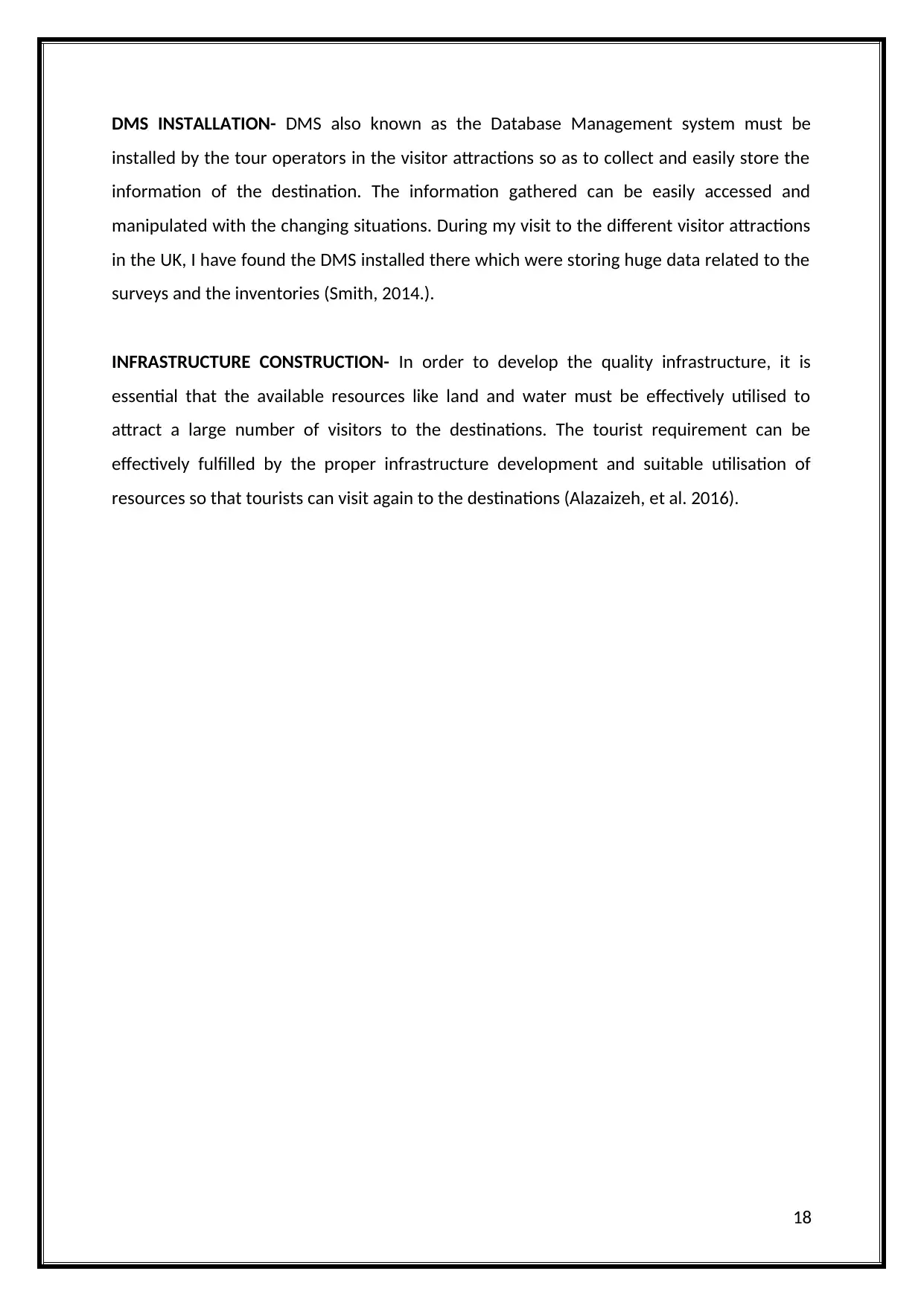
DMS INSTALLATION- DMS also known as the Database Management system must be
installed by the tour operators in the visitor attractions so as to collect and easily store the
information of the destination. The information gathered can be easily accessed and
manipulated with the changing situations. During my visit to the different visitor attractions
in the UK, I have found the DMS installed there which were storing huge data related to the
surveys and the inventories (Smith, 2014.).
INFRASTRUCTURE CONSTRUCTION- In order to develop the quality infrastructure, it is
essential that the available resources like land and water must be effectively utilised to
attract a large number of visitors to the destinations. The tourist requirement can be
effectively fulfilled by the proper infrastructure development and suitable utilisation of
resources so that tourists can visit again to the destinations (Alazaizeh, et al. 2016).
18
installed by the tour operators in the visitor attractions so as to collect and easily store the
information of the destination. The information gathered can be easily accessed and
manipulated with the changing situations. During my visit to the different visitor attractions
in the UK, I have found the DMS installed there which were storing huge data related to the
surveys and the inventories (Smith, 2014.).
INFRASTRUCTURE CONSTRUCTION- In order to develop the quality infrastructure, it is
essential that the available resources like land and water must be effectively utilised to
attract a large number of visitors to the destinations. The tourist requirement can be
effectively fulfilled by the proper infrastructure development and suitable utilisation of
resources so that tourists can visit again to the destinations (Alazaizeh, et al. 2016).
18
Paraphrase This Document
Need a fresh take? Get an instant paraphrase of this document with our AI Paraphraser
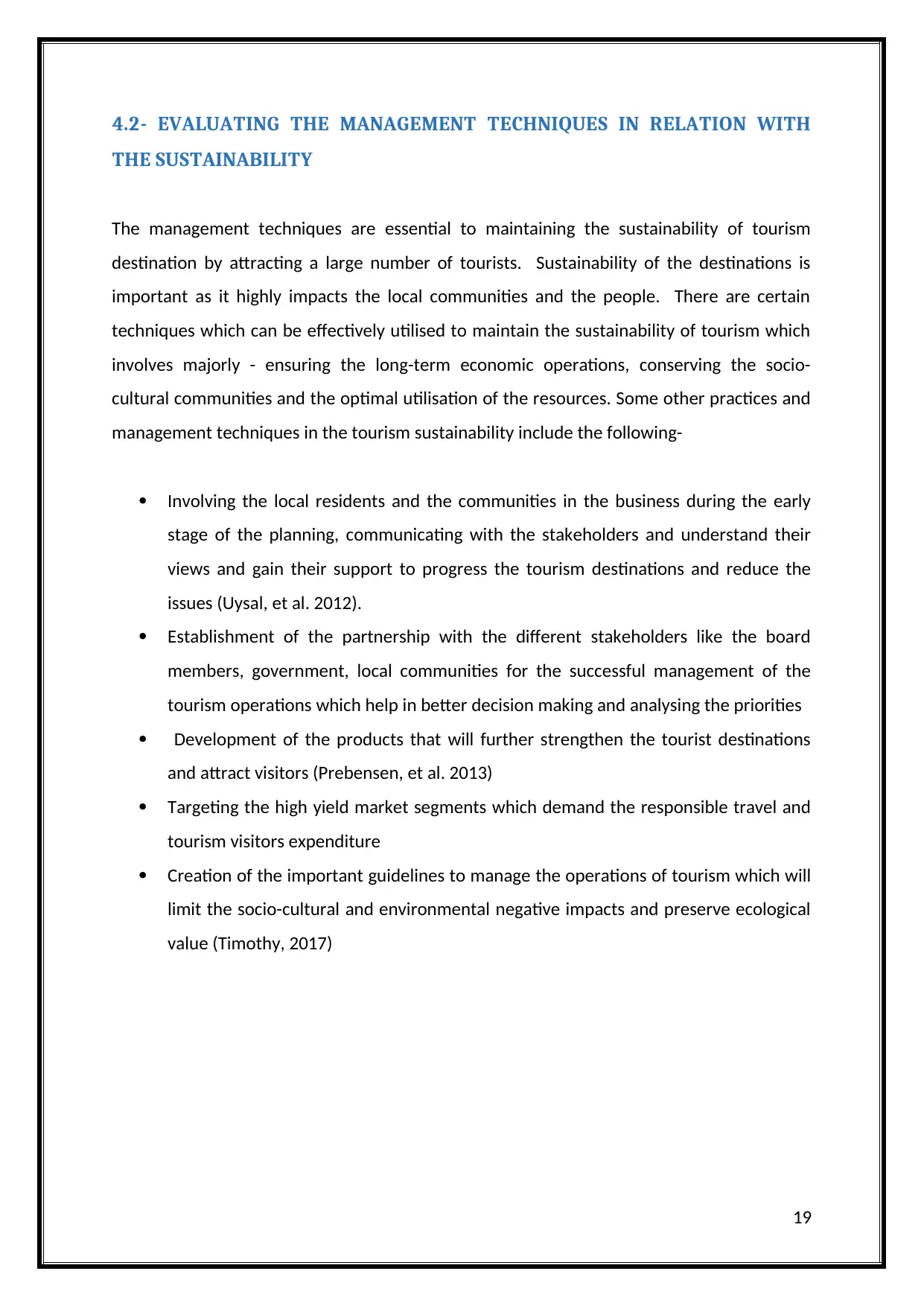
4.2- EVALUATING THE MANAGEMENT TECHNIQUES IN RELATION WITH
THE SUSTAINABILITY
The management techniques are essential to maintaining the sustainability of tourism
destination by attracting a large number of tourists. Sustainability of the destinations is
important as it highly impacts the local communities and the people. There are certain
techniques which can be effectively utilised to maintain the sustainability of tourism which
involves majorly - ensuring the long-term economic operations, conserving the socio-
cultural communities and the optimal utilisation of the resources. Some other practices and
management techniques in the tourism sustainability include the following-
Involving the local residents and the communities in the business during the early
stage of the planning, communicating with the stakeholders and understand their
views and gain their support to progress the tourism destinations and reduce the
issues (Uysal, et al. 2012).
Establishment of the partnership with the different stakeholders like the board
members, government, local communities for the successful management of the
tourism operations which help in better decision making and analysing the priorities
Development of the products that will further strengthen the tourist destinations
and attract visitors (Prebensen, et al. 2013)
Targeting the high yield market segments which demand the responsible travel and
tourism visitors expenditure
Creation of the important guidelines to manage the operations of tourism which will
limit the socio-cultural and environmental negative impacts and preserve ecological
value (Timothy, 2017)
19
THE SUSTAINABILITY
The management techniques are essential to maintaining the sustainability of tourism
destination by attracting a large number of tourists. Sustainability of the destinations is
important as it highly impacts the local communities and the people. There are certain
techniques which can be effectively utilised to maintain the sustainability of tourism which
involves majorly - ensuring the long-term economic operations, conserving the socio-
cultural communities and the optimal utilisation of the resources. Some other practices and
management techniques in the tourism sustainability include the following-
Involving the local residents and the communities in the business during the early
stage of the planning, communicating with the stakeholders and understand their
views and gain their support to progress the tourism destinations and reduce the
issues (Uysal, et al. 2012).
Establishment of the partnership with the different stakeholders like the board
members, government, local communities for the successful management of the
tourism operations which help in better decision making and analysing the priorities
Development of the products that will further strengthen the tourist destinations
and attract visitors (Prebensen, et al. 2013)
Targeting the high yield market segments which demand the responsible travel and
tourism visitors expenditure
Creation of the important guidelines to manage the operations of tourism which will
limit the socio-cultural and environmental negative impacts and preserve ecological
value (Timothy, 2017)
19
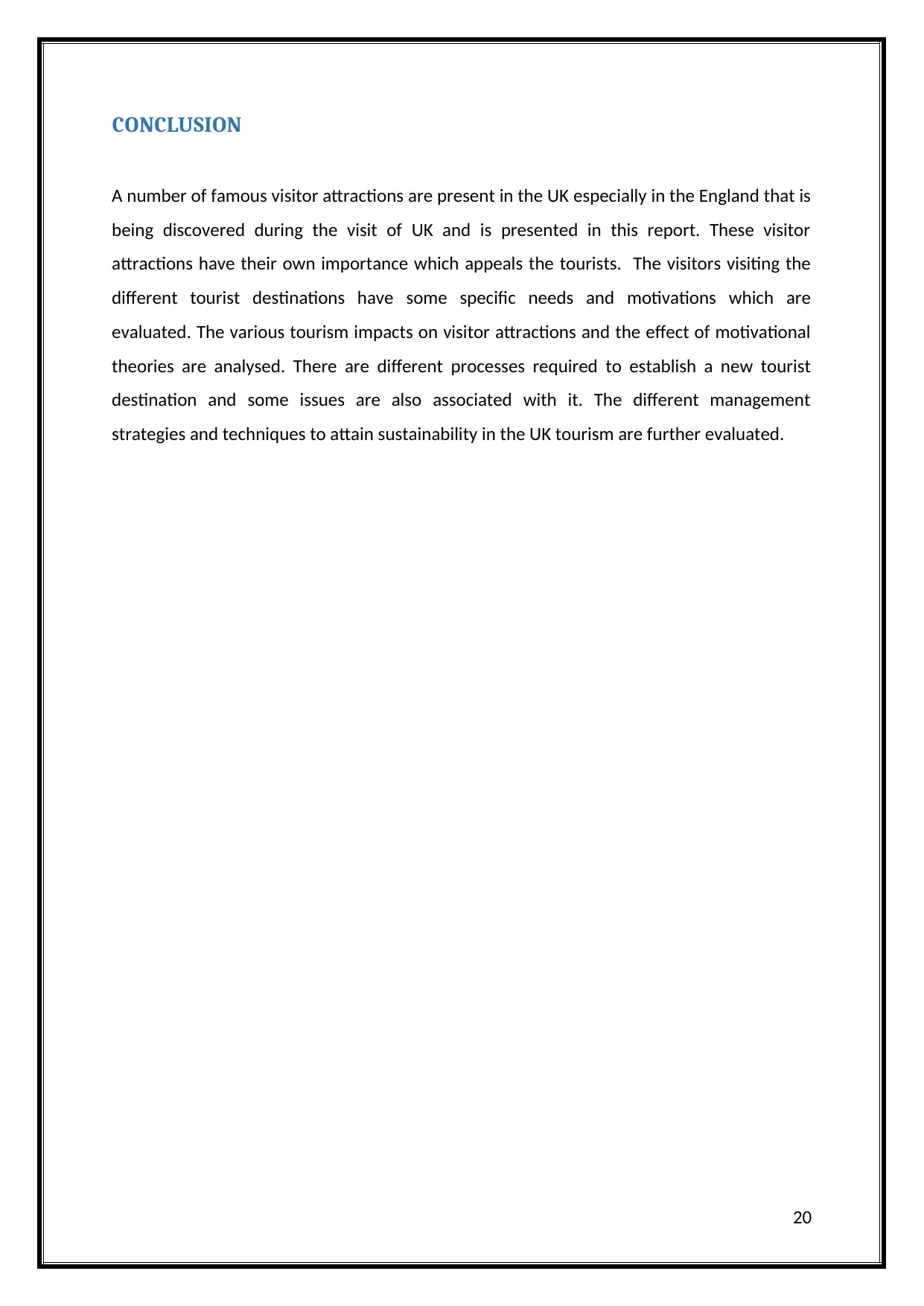
CONCLUSION
A number of famous visitor attractions are present in the UK especially in the England that is
being discovered during the visit of UK and is presented in this report. These visitor
attractions have their own importance which appeals the tourists. The visitors visiting the
different tourist destinations have some specific needs and motivations which are
evaluated. The various tourism impacts on visitor attractions and the effect of motivational
theories are analysed. There are different processes required to establish a new tourist
destination and some issues are also associated with it. The different management
strategies and techniques to attain sustainability in the UK tourism are further evaluated.
20
A number of famous visitor attractions are present in the UK especially in the England that is
being discovered during the visit of UK and is presented in this report. These visitor
attractions have their own importance which appeals the tourists. The visitors visiting the
different tourist destinations have some specific needs and motivations which are
evaluated. The various tourism impacts on visitor attractions and the effect of motivational
theories are analysed. There are different processes required to establish a new tourist
destination and some issues are also associated with it. The different management
strategies and techniques to attain sustainability in the UK tourism are further evaluated.
20
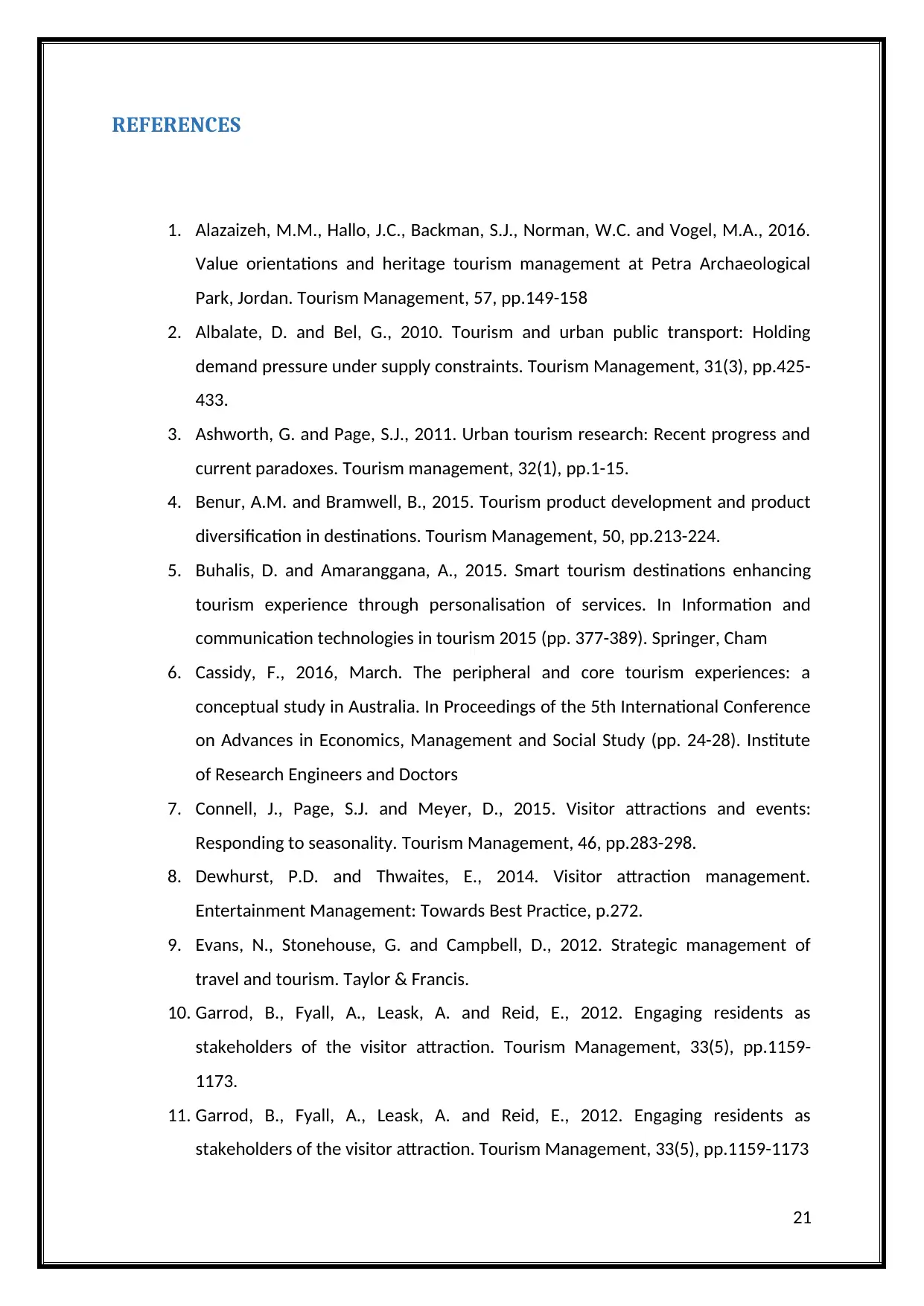
REFERENCES
1. Alazaizeh, M.M., Hallo, J.C., Backman, S.J., Norman, W.C. and Vogel, M.A., 2016.
Value orientations and heritage tourism management at Petra Archaeological
Park, Jordan. Tourism Management, 57, pp.149-158
2. Albalate, D. and Bel, G., 2010. Tourism and urban public transport: Holding
demand pressure under supply constraints. Tourism Management, 31(3), pp.425-
433.
3. Ashworth, G. and Page, S.J., 2011. Urban tourism research: Recent progress and
current paradoxes. Tourism management, 32(1), pp.1-15.
4. Benur, A.M. and Bramwell, B., 2015. Tourism product development and product
diversification in destinations. Tourism Management, 50, pp.213-224.
5. Buhalis, D. and Amaranggana, A., 2015. Smart tourism destinations enhancing
tourism experience through personalisation of services. In Information and
communication technologies in tourism 2015 (pp. 377-389). Springer, Cham
6. Cassidy, F., 2016, March. The peripheral and core tourism experiences: a
conceptual study in Australia. In Proceedings of the 5th International Conference
on Advances in Economics, Management and Social Study (pp. 24-28). Institute
of Research Engineers and Doctors
7. Connell, J., Page, S.J. and Meyer, D., 2015. Visitor attractions and events:
Responding to seasonality. Tourism Management, 46, pp.283-298.
8. Dewhurst, P.D. and Thwaites, E., 2014. Visitor attraction management.
Entertainment Management: Towards Best Practice, p.272.
9. Evans, N., Stonehouse, G. and Campbell, D., 2012. Strategic management of
travel and tourism. Taylor & Francis.
10. Garrod, B., Fyall, A., Leask, A. and Reid, E., 2012. Engaging residents as
stakeholders of the visitor attraction. Tourism Management, 33(5), pp.1159-
1173.
11. Garrod, B., Fyall, A., Leask, A. and Reid, E., 2012. Engaging residents as
stakeholders of the visitor attraction. Tourism Management, 33(5), pp.1159-1173
21
1. Alazaizeh, M.M., Hallo, J.C., Backman, S.J., Norman, W.C. and Vogel, M.A., 2016.
Value orientations and heritage tourism management at Petra Archaeological
Park, Jordan. Tourism Management, 57, pp.149-158
2. Albalate, D. and Bel, G., 2010. Tourism and urban public transport: Holding
demand pressure under supply constraints. Tourism Management, 31(3), pp.425-
433.
3. Ashworth, G. and Page, S.J., 2011. Urban tourism research: Recent progress and
current paradoxes. Tourism management, 32(1), pp.1-15.
4. Benur, A.M. and Bramwell, B., 2015. Tourism product development and product
diversification in destinations. Tourism Management, 50, pp.213-224.
5. Buhalis, D. and Amaranggana, A., 2015. Smart tourism destinations enhancing
tourism experience through personalisation of services. In Information and
communication technologies in tourism 2015 (pp. 377-389). Springer, Cham
6. Cassidy, F., 2016, March. The peripheral and core tourism experiences: a
conceptual study in Australia. In Proceedings of the 5th International Conference
on Advances in Economics, Management and Social Study (pp. 24-28). Institute
of Research Engineers and Doctors
7. Connell, J., Page, S.J. and Meyer, D., 2015. Visitor attractions and events:
Responding to seasonality. Tourism Management, 46, pp.283-298.
8. Dewhurst, P.D. and Thwaites, E., 2014. Visitor attraction management.
Entertainment Management: Towards Best Practice, p.272.
9. Evans, N., Stonehouse, G. and Campbell, D., 2012. Strategic management of
travel and tourism. Taylor & Francis.
10. Garrod, B., Fyall, A., Leask, A. and Reid, E., 2012. Engaging residents as
stakeholders of the visitor attraction. Tourism Management, 33(5), pp.1159-
1173.
11. Garrod, B., Fyall, A., Leask, A. and Reid, E., 2012. Engaging residents as
stakeholders of the visitor attraction. Tourism Management, 33(5), pp.1159-1173
21
Secure Best Marks with AI Grader
Need help grading? Try our AI Grader for instant feedback on your assignments.
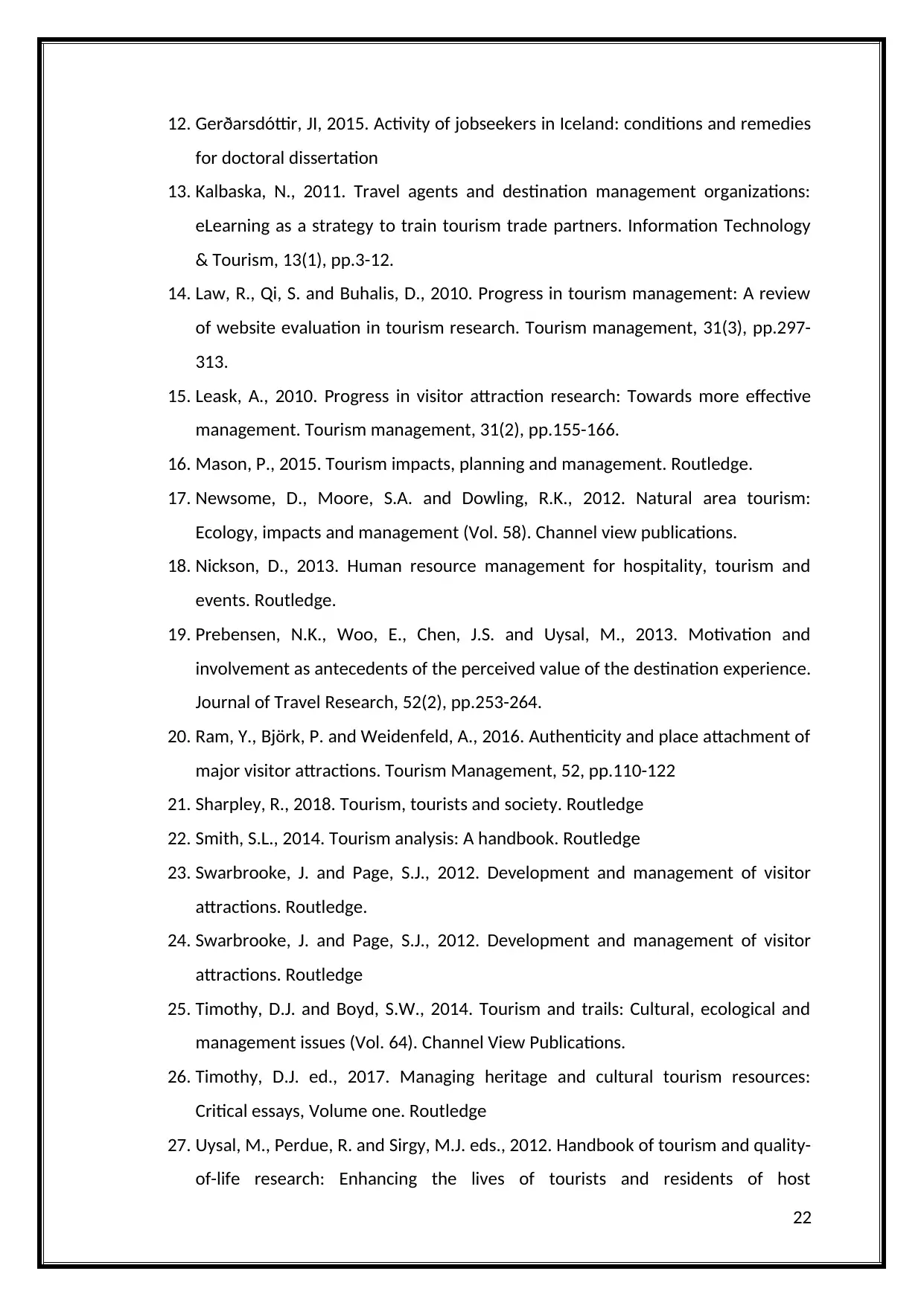
12. Gerðarsdóttir, JI, 2015. Activity of jobseekers in Iceland: conditions and remedies
for doctoral dissertation
13. Kalbaska, N., 2011. Travel agents and destination management organizations:
eLearning as a strategy to train tourism trade partners. Information Technology
& Tourism, 13(1), pp.3-12.
14. Law, R., Qi, S. and Buhalis, D., 2010. Progress in tourism management: A review
of website evaluation in tourism research. Tourism management, 31(3), pp.297-
313.
15. Leask, A., 2010. Progress in visitor attraction research: Towards more effective
management. Tourism management, 31(2), pp.155-166.
16. Mason, P., 2015. Tourism impacts, planning and management. Routledge.
17. Newsome, D., Moore, S.A. and Dowling, R.K., 2012. Natural area tourism:
Ecology, impacts and management (Vol. 58). Channel view publications.
18. Nickson, D., 2013. Human resource management for hospitality, tourism and
events. Routledge.
19. Prebensen, N.K., Woo, E., Chen, J.S. and Uysal, M., 2013. Motivation and
involvement as antecedents of the perceived value of the destination experience.
Journal of Travel Research, 52(2), pp.253-264.
20. Ram, Y., Björk, P. and Weidenfeld, A., 2016. Authenticity and place attachment of
major visitor attractions. Tourism Management, 52, pp.110-122
21. Sharpley, R., 2018. Tourism, tourists and society. Routledge
22. Smith, S.L., 2014. Tourism analysis: A handbook. Routledge
23. Swarbrooke, J. and Page, S.J., 2012. Development and management of visitor
attractions. Routledge.
24. Swarbrooke, J. and Page, S.J., 2012. Development and management of visitor
attractions. Routledge
25. Timothy, D.J. and Boyd, S.W., 2014. Tourism and trails: Cultural, ecological and
management issues (Vol. 64). Channel View Publications.
26. Timothy, D.J. ed., 2017. Managing heritage and cultural tourism resources:
Critical essays, Volume one. Routledge
27. Uysal, M., Perdue, R. and Sirgy, M.J. eds., 2012. Handbook of tourism and quality-
of-life research: Enhancing the lives of tourists and residents of host
22
for doctoral dissertation
13. Kalbaska, N., 2011. Travel agents and destination management organizations:
eLearning as a strategy to train tourism trade partners. Information Technology
& Tourism, 13(1), pp.3-12.
14. Law, R., Qi, S. and Buhalis, D., 2010. Progress in tourism management: A review
of website evaluation in tourism research. Tourism management, 31(3), pp.297-
313.
15. Leask, A., 2010. Progress in visitor attraction research: Towards more effective
management. Tourism management, 31(2), pp.155-166.
16. Mason, P., 2015. Tourism impacts, planning and management. Routledge.
17. Newsome, D., Moore, S.A. and Dowling, R.K., 2012. Natural area tourism:
Ecology, impacts and management (Vol. 58). Channel view publications.
18. Nickson, D., 2013. Human resource management for hospitality, tourism and
events. Routledge.
19. Prebensen, N.K., Woo, E., Chen, J.S. and Uysal, M., 2013. Motivation and
involvement as antecedents of the perceived value of the destination experience.
Journal of Travel Research, 52(2), pp.253-264.
20. Ram, Y., Björk, P. and Weidenfeld, A., 2016. Authenticity and place attachment of
major visitor attractions. Tourism Management, 52, pp.110-122
21. Sharpley, R., 2018. Tourism, tourists and society. Routledge
22. Smith, S.L., 2014. Tourism analysis: A handbook. Routledge
23. Swarbrooke, J. and Page, S.J., 2012. Development and management of visitor
attractions. Routledge.
24. Swarbrooke, J. and Page, S.J., 2012. Development and management of visitor
attractions. Routledge
25. Timothy, D.J. and Boyd, S.W., 2014. Tourism and trails: Cultural, ecological and
management issues (Vol. 64). Channel View Publications.
26. Timothy, D.J. ed., 2017. Managing heritage and cultural tourism resources:
Critical essays, Volume one. Routledge
27. Uysal, M., Perdue, R. and Sirgy, M.J. eds., 2012. Handbook of tourism and quality-
of-life research: Enhancing the lives of tourists and residents of host
22
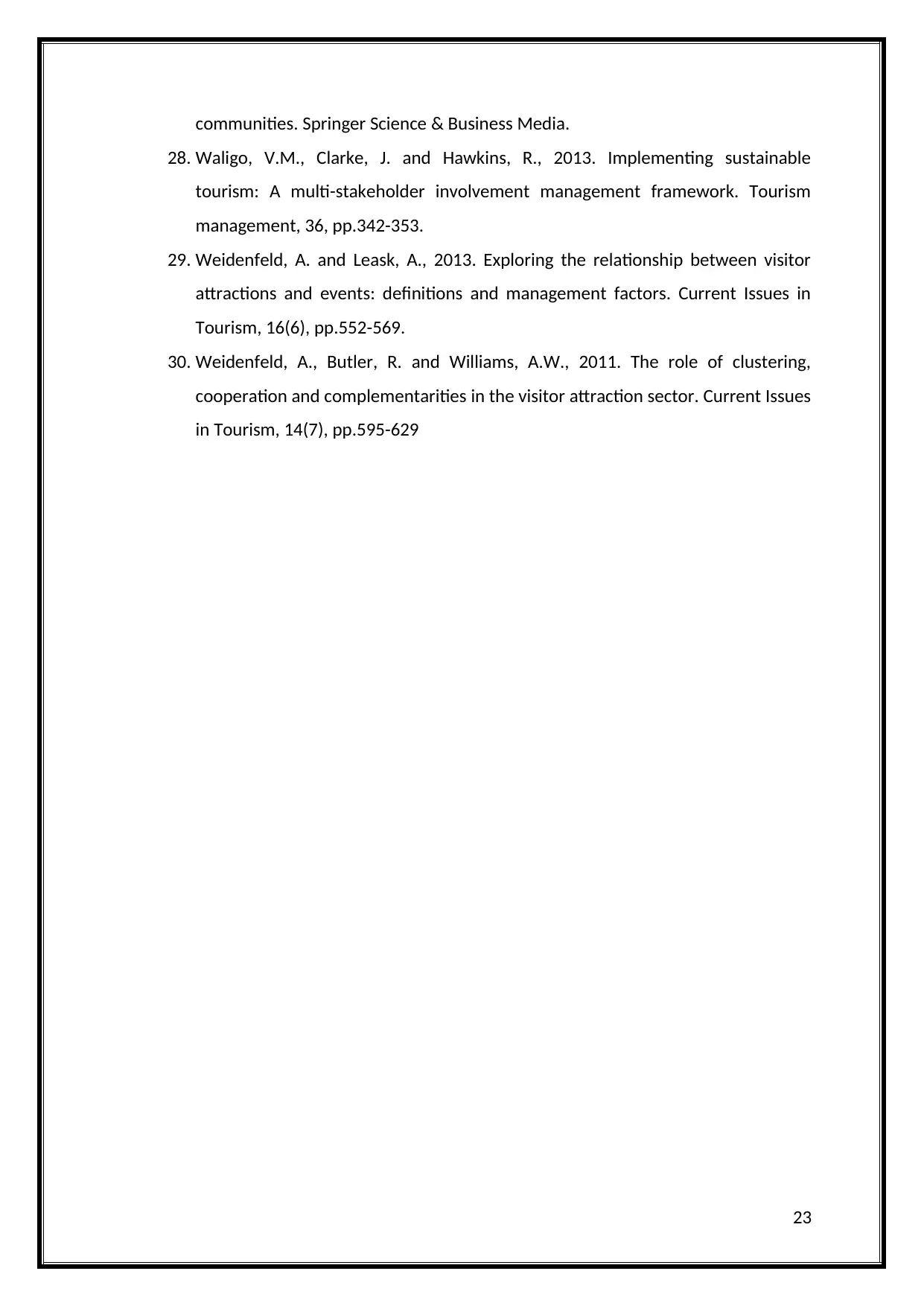
communities. Springer Science & Business Media.
28. Waligo, V.M., Clarke, J. and Hawkins, R., 2013. Implementing sustainable
tourism: A multi-stakeholder involvement management framework. Tourism
management, 36, pp.342-353.
29. Weidenfeld, A. and Leask, A., 2013. Exploring the relationship between visitor
attractions and events: definitions and management factors. Current Issues in
Tourism, 16(6), pp.552-569.
30. Weidenfeld, A., Butler, R. and Williams, A.W., 2011. The role of clustering,
cooperation and complementarities in the visitor attraction sector. Current Issues
in Tourism, 14(7), pp.595-629
23
28. Waligo, V.M., Clarke, J. and Hawkins, R., 2013. Implementing sustainable
tourism: A multi-stakeholder involvement management framework. Tourism
management, 36, pp.342-353.
29. Weidenfeld, A. and Leask, A., 2013. Exploring the relationship between visitor
attractions and events: definitions and management factors. Current Issues in
Tourism, 16(6), pp.552-569.
30. Weidenfeld, A., Butler, R. and Williams, A.W., 2011. The role of clustering,
cooperation and complementarities in the visitor attraction sector. Current Issues
in Tourism, 14(7), pp.595-629
23
1 out of 24
Related Documents
Your All-in-One AI-Powered Toolkit for Academic Success.
+13062052269
info@desklib.com
Available 24*7 on WhatsApp / Email
![[object Object]](/_next/static/media/star-bottom.7253800d.svg)
Unlock your academic potential
© 2024 | Zucol Services PVT LTD | All rights reserved.





